Microsoft RH-89 PCS CDMA Phone User Manual 2115i ENv2 9245785
Microsoft Mobile Oy PCS CDMA Phone 2115i ENv2 9245785
Manual
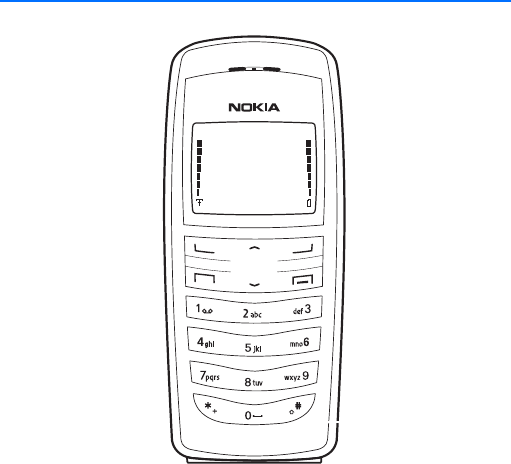
1
Nokia 2115i User Guide

2
LEGAL INFORMATION
The wireless phone described in this guide is approved for use in CDMA 1900 networks.
Part No. 9245785, Issue No. 2
Copyright © 2005 Nokia. All rights reserved.
Nokia, Nokia Connecting People, Nokia 2115i, Xpress-on, Pop-Port, and the Nokia Original
Enhancements logos are trademarks or registered trademarks of Nokia Corporation. Other
company and product names mentioned herein may be trademarks or trade names of their
respective owners.
US Patent No 5889770 and other pending patents.
T9 text input software Copyright ©1999-2005. Tegic Communications, Inc. All rights reserved.
Includes RSA BSAFE cryptographic or security protocol software from RSA Security.
The information contained in this user guide was written for the Nokia 2115i product. Nokia
operates a policy of ongoing development. Nokia reserves the right to make changes to any of
the products described in this document without prior notice.
UNDER NO CIRCUMSTANCES SHALL NOKIA BE RESPONSIBLE FOR ANY LOSS OF DATA OR INCOME
OR ANY SPECIAL, INCIDENTAL, AND CONSEQUENTIAL OR INDIRECT DAMAGES HOWSOEVER
CAUSED. THE CONTENTS OF THIS DOCUMENT ARE PROVIDED “AS IS.” EXCEPT AS REQUIRED BY
APPLICABLE LAW, NO WARRANTIES OF ANY KIND, EITHER EXPRESS OR IMPLIED, INCLUDING,
BUT NOT LIMITED TO, THE IMPLIED WARRANTIES OF MERCHANTABILITY AND FITNESS FOR A
PARTICULAR PURPOSE, ARE MADE IN RELATION TO THE ACCURACY AND RELIABILITY OR
CONTENTS OF THIS DOCUMENT. NOKIA RESERVES THE RIGHT TO REVISE THIS DOCUMENT OR
WITHDRAW IT AT ANY TIME WITHOUT PRIOR NOTICE.
EXPORT CONTROLS
This device may contain commodities, technology, or software subject to export laws and
regulations from the U.S. and other countries. Diversion contrary to law is prohibited.
FCC/INDUSTRY CANADA NOTICE
Your phone may cause TV or radio interference (for example, when using a telephone in close
proximity to receiving equipment). The FCC or Industry Canada can require you to stop using
your telephone if such interference cannot be eliminated. If you require assistance, contact
your local service facility. This device complies with part 15 of the FCC rules. Operation is
subject to the condition that this device does not cause harmful interference.
Contents
3
Contents
For your safety .......................................................................................................... 5
Welcome..................................................................................................................... 7
1. Phone at a glance ........................................................................................... 11
2. Set up your phone........................................................................................... 17
3. Text entry........................................................................................................... 25
4. Contacts ............................................................................................................ 28
5. My Account....................................................................................................... 39
6. Messaging ........................................................................................................ 40
7. VirginXtras......................................................................................................... 54
8. Recent calls ..................................................................................................... 57
9. Settings ............................................................................................................. 60
10.Tools ................................................................................................................... 75
11.Games ................................................................................................................ 85
12.Enhancements.................................................................................................. 86
13.Purchasing accessories .................................................................................. 88
14.Battery information........................................................................................ 89
Care and maintenance......................................................................................... 93
Contents
4
Additional safety information ........................................................................... 95
Nokia one-year limited warranty ................................................................... 102
Index....................................................................................................................... 107
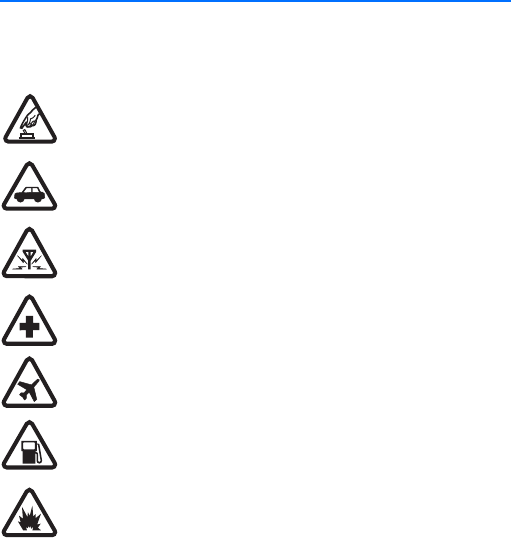
For your safety
5
For your safety
Read these simple guidelines. Not following them may be dangerous or illegal.
Read the complete user guide for further information.
SWITCH ON SAFELY
Do not switch the phone on when wireless phone use is prohibited or
when it may cause interference or danger.
ROAD SAFETY COMES FIRST
Obey all local laws. Always keep your hands free to operate the vehicle
while driving. Your first consideration while driving should be road safety.
INTERFERENCE
All wireless phones may be susceptible to interference, which could
affect performance.
SWITCH OFF IN HOSPITALS
Follow any restrictions. Switch the phone off near medical equipment.
SWITCH OFF IN AIRCRAFT
Follow any restrictions. Wireless phones can cause interference in aircraft.
SWITCH OFF WHEN REFUELING
Do not use the phone at a refueling point. Do not use near
fuel or chemicals.
SWITCH OFF NEAR BLASTING
Follow any restrictions. Do not use the phone where blasting is in progress.

For your safety
6
USE SENSIBLY
Use only in the normal position as explained in the product
documentation. Don't touch the antenna unnecessarily.
QUALIFIED SERVICE
Only qualified personnel may install or repair this product.
ENHANCEMENTS AND BATTERIES
Use only approved enhancements and batteries. Do not connect
incompatible products.
WATER-RESISTANCE
Your phone is not water-resistant. Keep it dry.
BACKUP COPIES
Remember to make backup copies or keep a written record of all
important information stored in your phone.
CONNECTING TO OTHER DEVICES
When connecting to any other device, read its user guide for detailed
safety instructions. Do not connect incompatible products.
EMERGENCY CALLS
Ensure the phone is switched on and in service. Press End as many
times as needed to clear the display and return to the main screen. Key
in the emergency number, then press Call. Give your location. Do not
end the call until given permission to do so.

Welcome
7
Welcome
Congratulations on your purchase of the Nokia 2115i mobile phone. Your phone
provides many functions which are practical for daily use, such as a hands-free
speakerphone, alarm clock, calculator, calendar, and more. To personalize your
phone, you can set your favorite ringtones and select an Xpress-onTM color cover.
■About your phone
The wireless phone described in this guide is approved for use on CDMA 1900
networks. Contact Virgin Mobile for more information about networks.
When using this phone, or any of its features, obey all laws and respect privacy and
legitimate rights of others.
Warning: To use any features in this phone, other than the alarm clock,
the phone must be switched on. Do not switch the phone on when wireless
phone use may cause interference or danger.
■Network Services
To use the phone you must have service from Virgin Mobile. Many of the phone’s
features depend on your service provider’s network to function. These Network
Services may not be available on all networks or you may have to make specific
arrangements with Virgin Mobile before you can utilize Network Services. Virgin
Mobile may need to give you additional instructions for their use and explain what
charges will apply. Some networks may have limitations that affect how you can
use network services. For instance, some networks may not support all language-
dependent characters and services.

Welcome
8
■Shared memory
The following features in this phone may share memory: contacts, text messages,
ringtones, calendar, and games. Use of one or more of these features may reduce
the memory available for the remaining features sharing memory. Your phone may
display a message that the memory is full when you try to use a shared memory
feature. In this case, delete some of the information or entries stored in the shared
memory features before continuing. Some features, such as messages and ringtones,
may have a certain amount of memory specially allotted to them in addition to the
memory shared with other features.
■Register your phone
Make sure to register your phone at www.warranty.nokiausa.com or call
1-888-NOKIA-2U (1-888-665-4228) so that we can serve your needs better
if you should need to call a customer center or have your phone repaired.
■Get help
Find your device label
If you need help, Nokia Customer Care is available for assistance. Before calling,
we recommend that you write down the electronic serial number (ESN) and
have it available.
The ESN is found on the type label, which is located beneath the battery on the
back of the phone.

Welcome
9
Contact Virgin Mobile
To contact Virgin Mobile’s Customer Support department for information about
your phone, account history, call coverage area, and specific features available to
you, such as call forwarding or voicemail:
•Go to www.virginmobileusa.com.
•Dial *VM from your Virgin Mobile phone.
• Dial 888-322-1122 from any phone.
Contact Nokia
Please have your product with you when contacting Nokia.
Nokia Inc.
4630 Woodland Corporate Blvd. Ste. 160
Tampa, FL 33614
Telephone: 1-999-NOKIA-2U (1-888-665-4228)
Facsimile: 1-813-249-9619
TTY/TDD Users: 1-800-24-NOKIA (1-800-246-6542)
www.nokiausa.com
Updates
From time to time, Nokia updates this guide to reflect changes. The latest version
may be available at www.nokiausa.com. An interactive tutorial for this product
may be available in the support area on the Nokia web site, www.nokiausa.com.

Welcome
10
Accessibility solutions
Nokia is committed to making mobile phones easy to use for all individuals,
including those with disabilities. For more information visit the web site at
www.nokiaaccessibility.com.
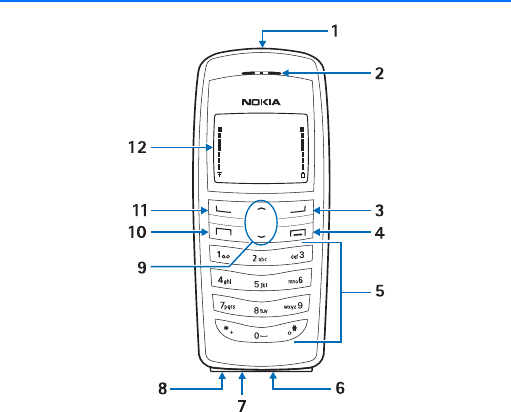
Phone at a glance
11
1. Phone at a glance
Power key (1) Microphone (7)
Earpiece (2) Charger port (8)
Right selection key (3) Scroll up and down key (9)
End key (4) Call key (10)
Keypad (5) Left selection key (11)
Connection port (6) Screen (12)
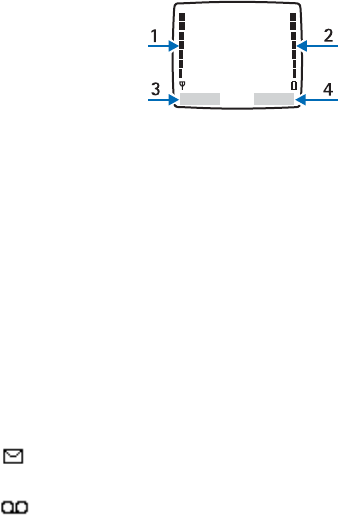
Phone at a glance
12
■The main screen
The main screen appears when your phone is in idle mode.
Signal strength (1)—A higher bar indicates a stronger network signal.
Battery level (2)—A higher bar indicates more power in the battery.
Menu (3)—Press the Left selection key to select this option.
Contacts (4)—Press the Right selection key to select this option.
■Quick keys
At the main screen, press and hold * to activate or deactivate the flashlight. Scroll
up to access My Account (see "My Account," page 38), or scroll down to access the
list of entries in the phone book (contents of the contacts list).
■Indicators and icons
Icon Indicates...
You have one or more text messages.
See "Read a message," page 42.
You have one or more voice messages.
See "Voice messages," page 48.

Phone at a glance
13
You are making a call with the phone.
See "Make a call," page 22.
Your phone keypad is locked. See "Keyguard," page 24.
Your phone is set to the silent profile. The icon is also present
whenever you silence the ringtone. See "Profiles," page 55.
The alarm clock is set to On. See "Alarm clock," page 69.
The countdown timer is running.
See "Countdown timer," page 75.
The stopwatch timing is running in the background.
See "Stopwatch," page 76.
Speakerphone is enabled.
The timed profile is selected. See "Profiles," page 55.
,or ,
or
An enhancement is connected to the phone.
or Voice privacy encryption is active (or is not active) in
the network.
or Location info sharing is set to Emergency or On.
See "Location info sharing," page 57.
The phone is in an 1XRTT network.
See "Network Services," page 7.
Icon Indicates...

Phone at a glance
14
■Get the most out of this guide
The following sections illustrate the various components of your phone. Familiarize
yourself with these sections to help you understand the instructions that follow.
This guide uses certain terms for the steps that you are asked to perform:
• "Press" means to press and release a key quickly. For example, press 7 means press
the key on the keypad that is labeled with the number 7 and the letters pqrs.
• "Press and hold" means to press and hold a key for 2–3 seconds, then release
the key.
• Selection keys are used to select menu options. To select an option, press the
selection key below the menu item on the phone screen.
• Scroll keys are used to move up and down in the menus.
• Press Call to place a call or to answer an incoming call.
• Press End to end a call or press and hold to return to idle mode at the main screen.
■Phone menus
Phone features are grouped according to function and are accessed through the
main menus. Each main menu contains submenus and lists from which you can
select or view items and customize your phone features. You can access these
menus and submenus by scrolling with the up and down scroll key.
Scroll method
1. At the main screen, select Menu, and scroll through the main menu using the
up and down scroll key.
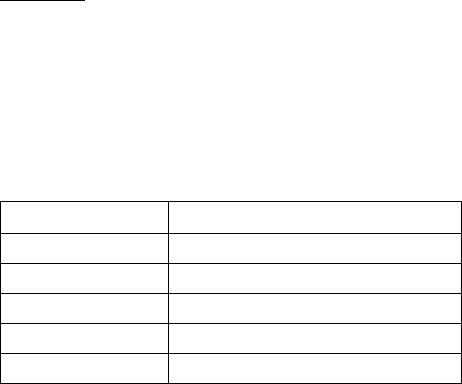
Phone at a glance
15
2. When you arrive at a menu, press Select (the Left Selection key) or Connect to
enter submenus.
• Select Back from the submenu level to return to the previous menu.
• Select Exit from the main menu level or press End to return to the main
screen from any menu or submenu.
Shortcuts
You can use a shortcut to go directly to almost any menu or submenu and to
activate most features.
At the main screen, select Menu; then within 3 seconds press the key or keys
associated with the menu function you would like to view or activate.
For example, to quickly display your phone number, select Menu 5-9 from the main
screen (Menu > 5 Contacts >9My phone no. ). After a brief pause, the phone
displays your phone number.
Common shortcuts
Shortcut Keys
My Account
Menu
1
Check balance
Menu
1-1
Top-Up
Menu
1-2
VirginXtras
Menu
3, or press and hold 0
Virgin Alerts
Menu
2-1-3

Phone at a glance
16
In-phone help
Many features have brief descriptions (help text) that you can view on the phone.
To view these descriptions, scroll to a feature and wait for about 10 seconds.
If needed, select More to view all of the description or Back to exit.
In order to view the descriptions, you must first activate help text.
1. At the main screen, select Menu > Settings > Phone settings > Help text activation.
2. Select On to display help text or Off to turn this feature off.
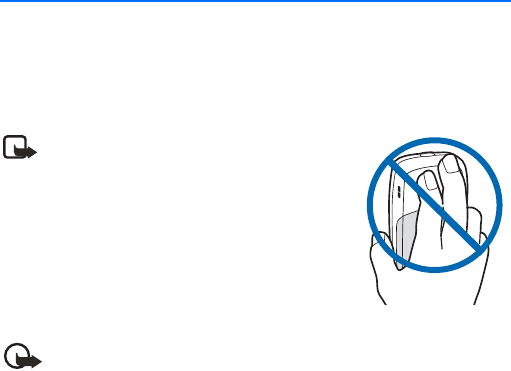
Set up your phone
17
2. Set up your phone
■The antenna
Your phone has an internal antenna located towards the top of the phone. Hold the
phone as you would any other telephone with the antenna area pointed up and
over your shoulder.
Note: As with any other radio transmitting
phone, do not touch the antenna unnecessarily
when the phone is switched on. Contact with
the antenna affects call quality and may cause
the phone to operate at a higher power level
than otherwise needed. Avoid contact with the
antenna area when operating the phone to
optimize antenna performance and battery life.
■The battery
Important: Always switch the phone off and disconnect the charger before
removing the battery.
Before removing the cover, always switch off the power and disconnect the charger
and any other phone. Avoid touching electronic components while changing the
covers. Always store and use the phone with the covers attached.
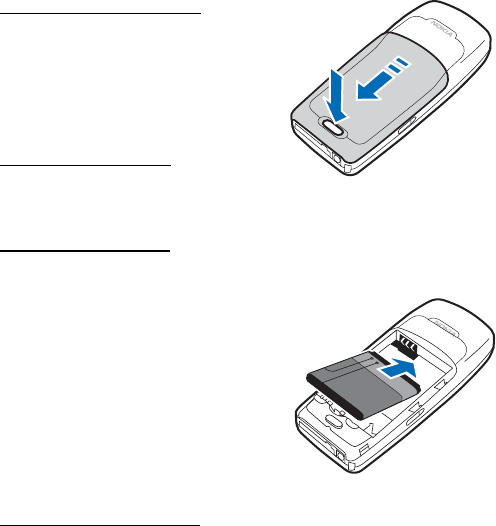
Set up your phone
18
Remove the back cover
1. With the back of the phone facing
you, push down on the button on the
back of the phone.
2. Slide the back cover toward the
bottom of the phone and remove.
Remove the battery
After you have removed the back cover,
insert your finger into the finger grip and lift the battery from its compartment.
Replace the battery
Always use original Nokia batteries. See "Battery information," page 83.
1. Position the battery so the gold-colored
contacts match up with those on
the phone.
The battery label must face away from
the phone.
2. Insert the battery, gold-colored contact
end first, into the battery slot.
3. Push down on the other end of the
battery to snap the battery into place.
Replace the back cover
Slide the back cover toward the top of the phone until you hear a click and see the
back cover release button.
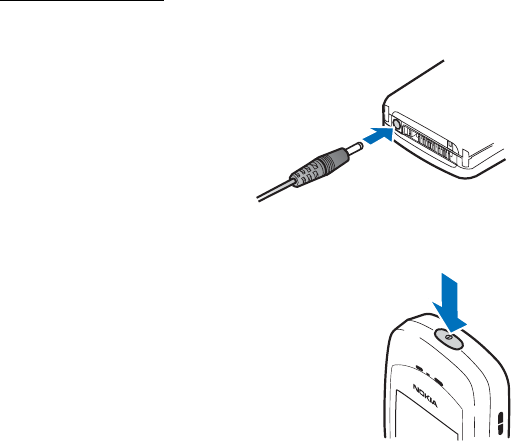
Set up your phone
19
Charge the battery
1. Plug the charger transformer into a standard AC outlet.
2. Insert the charger output plug into
the round jack at the bottom end
of the phone.
After a few seconds, the battery
indicator in the display starts to
scroll from bottom to top. If the
battery is completely drained, it
may take a few minutes before the
charging indicator appears on the
display or any calls can be made.
■Switch on or off
To switch your phone on or off, press and hold the power
key on top of the phone for at least 3 seconds.
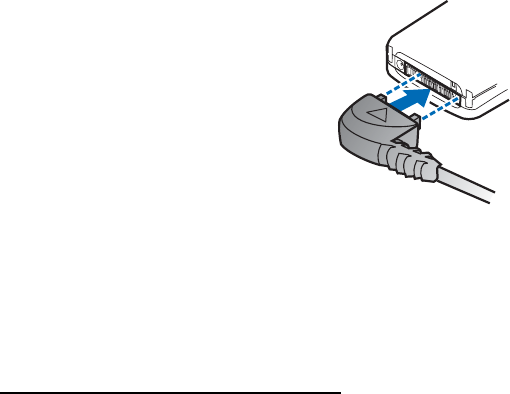
Set up your phone
20
■Connect the headset
A compatible headset may be included with your
phone or purchased separately as an enhancement.
See "Enhancements," page 80.
1. Plug the headset connector into the Pop-Port™
connector at the bottom end of your phone.
2. Position the headset on your ear.
With the headset connected, you can make,
answer, and end calls as usual.
• Use the keypad to enter numbers.
• Press Call to place a call.
• Press End to end a call.
■Change Xpress-on™ covers
Before removing the cover, always switch off the power and disconnect the
charger and any other phone. Avoid touching electronic components while
changing the covers. Always store and use the phone with the covers attached.
Remove the back cover and the battery
For instructions on removing the back cover and the battery, see "Remove the back
cover," page 18 and "Remove the battery," page 18.
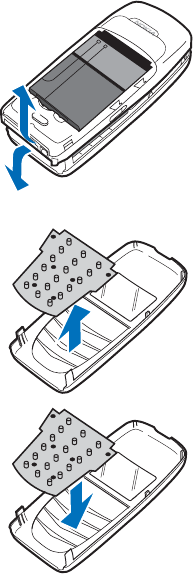
Set up your phone
21
Remove the front cover
Gently pull the bottom of the front cover away
from the rest of the phone, and remove the
front cover.
Install the key mat and front cover
1. Remove the key mat from the
old front cover.
2. Place the key mat into the new front cover.
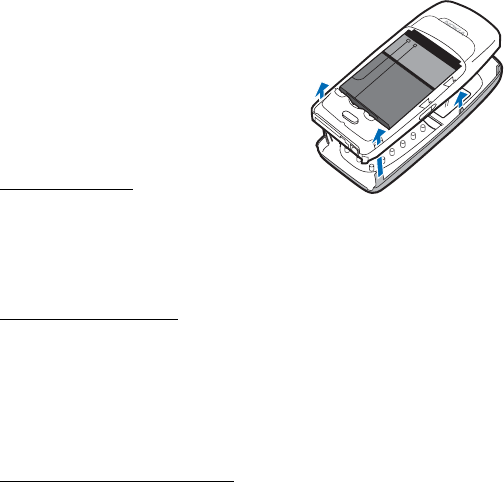
Set up your phone
22
3. Press the front cover and key mat against the
phone, and snap the front cover into place.
Replace the battery and back cover
See "Replace the battery," page 18 and
"Replace the back cover," page 18.
■Make a call
Use the keypad
1. Enter the phone number (including the
area code), and press Call.
(To delete a character to the left of the cursor, select Clear.)
2. Press End to end the call or to cancel the call attempt.
Use the contacts list
To enter a number into the contacts list, at the main screen, select Contacts > Add
new, and enter the name and phone number. See "Save an entry," page 29.
1. At the main screen, scroll down to display the contents of your contacts list.
2. Select a contact from the list.
3. Press Call to make the call, or select Details to view details of the entry.
Use the last dialed number
1. At the main screen, press Call to display the last 20 numbers dialed.
2. Scroll to the number (or name) you wish to redial, and press Call.

Set up your phone
23
■Answer calls
Answer or silence/decline
1. Press Call, or select Answer to answer the call.
2. To mute the ringtone, select Silence. If you do not answer the call, the call is
eventually forwarded to voicemail.
3. To decline and forward the call to voicemail, select Decline after you have
muted the ringtone, or press End at any time.
Answer a call with locked keypad
To answer a call with the keypad locked, press Call. During the call, all features
function as normal. When you end or decline the call, the keypad automatically
relocks. See "Keyguard," page 24.
When the phone is locked, calls may be possible to the official emergency number
programmed into your phone.
Adjust the volume during a call
To increase or decrease the volume during a call, scroll up or down during the call.
When adjusting the volume, a bar chart indicates the volume level.
Speakerphone
You can use the speakerphone, or loudspeaker, on your phone during a call.
Warning: Do not hold the phone near your ear when the speakerphone is
in use because the volume may be extremely loud.
• To activate the speakerphone while in a call, select Loudsp.

Set up your phone
24
• To deactivate the speakerphone during a call, select Handset.
The speakerphone is deactivated automatically when a call (or a call attempt) ends
or when certain enhancements are connected.
Options during a call
Many of the options that you can use during a call, are network services.
Check with Virgin Mobile for more information.
Select Options during a call to display a list of options available during a call, then
select an option.
■Keyguard
With keyguard, you can lock the keypad to prevent keys from being pressed
accidentally and prevent accidental calls. If the keypad is locked, it unlocks when
you receive a call. After the call, the lock automatically reactivates.
When keyguard is on, it is still possible to dial the official emergency number
programmed into your phone.
To lock the keypad, select Menu and press * within 2 seconds.
To unlock the keypad, select Unlock and press * within 2 seconds.
■Flashlight
Your phone has a built-in flashlight that you can activate
when the phone is in idle mode or when there is a call in
progress. To activate the flashlight, press and hold *. The
light stays on until you press and hold * again.
You can also use the flashlight to alert you to an incoming
call. For more information, see "Personalize a profile,"
page 55.

Text entry
25
3. Text entry
You can use two methods for entering text and numbers:
• Standard mode is the only way to enter text into the contacts list, and to
rename caller groups.
• Predictive text is a quick and easy method for writing messages and creating a
calendar note.
■Standard mode
Text (Abc)
• Press a key once to insert the first letter on the key, twice for the second letter,
etc. If you pause briefly, the last letter in the display is accepted and your phone
awaits the next entry.
•Press 0 to enter a space and accept a completed word.
•Press 1 to enter a period (.).
•Press * to display special characters. See more about special characters on the
following pages.
•Press # to change the text input mode. The following icons (not the
descriptions) appear in the upper left of the display screen:
Uppercase text: standard mode is on.
Lowercase text: standard mode is on.
Sentence case text: standard mode is on.

Text entry
26
Numbers (123)
To switch to 123 mode from Abc mode, press and hold # at any message entry
screen until the icon in the upper left corner of the display switches from Abc to
123 (or vice versa).
• Select Clear to backspace the cursor and delete a character.
• Select and hold Clear to backspace continuously and delete characters.
Punctuation and special characters
While at any text entry screen, press * to display special characters (press and hold *
if predictive text is on). To navigate through the list of special characters, use the
scroll key. Once a character is highlighted, select Insert to insert the character into
your message.
■Predictive text input
Predictive text input allows you to write messages quickly using your keypad and
the built-in dictionary. It is much faster than the standard mode method, because
the phone guesses the words as you type them.
Activate or deactivate
At any text entry screen, select Options > Predictive text.
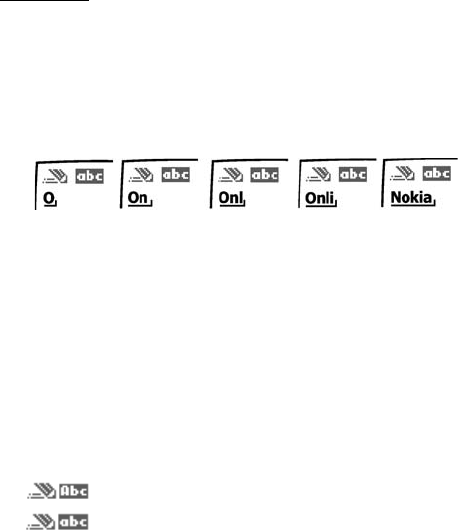
Text entry
27
Text entry
This example describes text entry using predictive text. To write the word "Nokia"
with predictive text on, press each of the following displayed number keys once.
This illustration shows the text displayed on your screen as you press 6-6-5-4-2.
Predictive text estimates which of the three or four letters corresponds to the
number on the keypad you pressed, as shown:
Enter: 6 6 5 4 2
When using predictive text:
•Press 0 to enter a space between words.
• If a displayed word is not correct, press * to display another match. To return to
the previous word in the list of matches, select Previous.
•If ? appears after a word, select Spell to add the word to the dictionary.
•Press 1 to insert a period into your message.
•Press and hold * to display special characters. Press * again to cycle through all
available characters.
•Press # to switch predictive text on or off and to use predictive text in various
modes. As you press #, the following icons (not the descriptions) appear in the
upper left of the display screen:
Sentence case text: predictive text is on.
Lowercase text: predictive text is on.
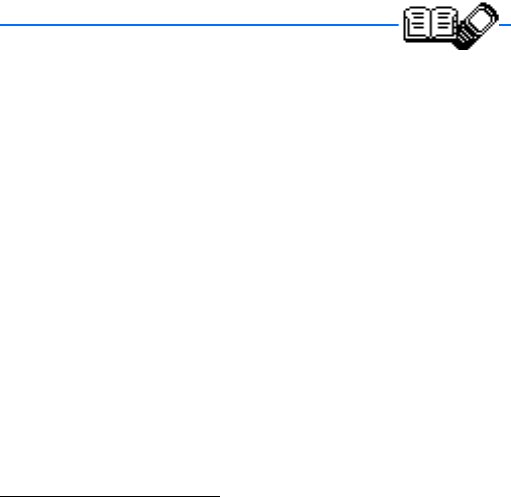
Contacts
28
4. Contacts
The contacts list can hold up to 250 contacts, with multiple
numbers and text notes for each contact. The amount of numbers and text entries
that you can save may vary, depending on length and the total number of entries in
the contacts list.
■Contacts options
You can access contacts options in one of two ways:
• At the main screen, select Contacts.
• At the main screen, select Menu > Contacts.
In this chapter, to access contacts options, select Contacts.
■Search
1. At the main screen, select Contacts > Search.
2. Type in the first character of the contact name and highlight the contact you
wish to view.
3. Select Details >Options and the action you want to apply to the contact.
■Add new contacts
Save a name and number
1. At the main screen, enter the phone number you wish to save.
2. Select Options > Save.
3. Enter the name, and select OK.

Contacts
29
Save (only) a number
1. At the main screen, enter the phone number you wish to save.
2. Select and hold Options.
Save an entry
1. At the main screen, select Contacts > Add new.
2. Enter the name, and select OK.
3. Enter the phone number, and select OK > Done.
Save numbers and details
You can save different types of phone numbers and short text items per name to
the contacts list. The first number you save for any entry is automatically set as the
default, but the default number can always be changed. You can save details such
as addresses and notes as contact information.
1. At the main screen, scroll down to display a list of entries in your contacts list.
2. Scroll to the entry to which you wish to add a phone number or text item.
3. Select Details > Options > Add number or Add detail.
4. Select General, Mobile, Home, Work, or Fax type when adding a number; or
select E-mail, Web address, Street addr., or Note when adding details.
5. Enter the number or text for the type you have selected, and selectOK.
6. To change the type, select Change type in the options list.
Change the default number
To change the default number for the contact entry:
1. At the main screen, scroll down to the entry you wish to change, and select Details.
2. Scroll to the number you wish to set as default, and select Options > As primary no.
Contacts
30
■Edit contact name
1. At the main screen, select Contacts > Edit name.
2. Scroll to the entry you wish to change and select Edit.
3. Enter your changes; then select OK.
■Delete contacts list entries
1. At the main screen, select Contacts > Delete.
2. To delete individual entries, select One by one.
3. Scroll to the entry you wish to delete, and select Delete > OK to confirm.
4. To delete the entire contents of your contacts list, select Delete all > OK.
5. Enter the lock code, and select OK. See "Security settings," page 66.
■Add number list entries
Add number allows you to add another number to an existing contact.
1. At the main screen, select Contacts > Add number.
2. Highlight a contact from the list and select Add.
3. Select the tag General, Mobile, Home, Work, or Fax and enter the number.
■Settings
Settings allows you to determine how your phone numbers will be viewed and how
much memory remains in the contacts list.
At the main screen, select Contacts > Settings and one of the following:
Scrolling view—Specify how names and numbers are viewed in Contacts list.
Memory status—View the amount of space available in Contacts list.

Contacts
31
■Speed dialing
You can associate any entry in the contacts list with a key from 2–9. To dial those
entries, press and hold the assigned key. Speed dialing must be turned on to use
this method.
Press the assigned key and Call to speed dial at any time.
Assign a key to speed dial
1. At the main screen, select Contacts > Speed dials.
2. Select any empty slot and Assign.
3. Enter the number (including the area code), and select OK; or select Search to
retrieve a number from the contacts list.
4. Enter the contact name for the number, and select OK.
If speed dial is off, the phone displays a prompt asking if you would like to turn
speed dial on.
5. Select Yes to activate speed dial.
Change speed dial numbers
1. At the main screen, select Contacts > Speed dials.
2. Select the speed dial entry you wish to change and Options > Change.
3. Enter the new number and select OK; or select Search to view the contacts list
and select a new number.
4. Enter a name for the entry, and select OK.
Delete speed dial numbers
1. At the main screen, select Contacts > Speed dials.
2. Select the speed dial location you wish to delete.
3. Select Options > Delete > OK to delete the key assignment.

Contacts
32
■Voice tags
Voice tags allow you to dial a contact by speaking. You can also playback, change,
or delete voice tags.
Voice dialing
You can dial up to 25 stored numbers using voice dialing.
Before using voice tags, note the following:
• Voice tags are not language dependent. They are dependent on your voice.
• You must say the name exactly as you said it when you recorded it.
• Voice tags are sensitive to background noise. Record voice tags and use them in
a quiet environment.
• Very short names are not accepted. Use long names, and avoid similar names
for different numbers.
Using voice tags may be difficult in a noisy environment or during an emergency,
so you should not rely solely upon voice dialing in all circumstances.
Add a voice tag to a contact
Before you can use voice dialing, you must first assign a voice tag to the number.
1. At the main screen, use scroll down to enter the contacts list.
2. Highlight the contact you want to add a voice tag, and select Details >
Options > Add voice tag.
3. Select Start; then speak clearly into the phone.
Do not select Quit unless you want to cancel the recording.
The phone automatically stops recording, saves, and replays the voice tag.
appears next to the phone numbers that have voice tags assigned.

Contacts
33
Dial a number
1. At the main screen, select and hold Contacts.
2. When you hear several beeps and Speak now appears, release the key.
3. Say the voice tag clearly into the phone.
When the phone finds the voice tag, Found: appears, and the phone automatically
dials the number. If the phone does not locate a number or recognize the voice
tag, No match found appears.
Voice tag options
After you have added a voice tag to a contact, you can choose one of the
following options:
Playback
1. At the main screen, select Menu > Contacts > Voice tags.
2. Scroll to the name with the voice tag you want to hear.
3. Select Options > Playback.
Modify
1. At the main screen, select Menu > Contacts > Voice tags.
2. Scroll to the name with the voice tag you want to change.
3. Select Options > Change.
4. Select Start, then speak clearly into the phone. The phone repeats your voice
tag, and Voice tag saved appears.

Contacts
34
Delete
1. At the main screen, select Menu > Contacts > Voice tags.
2. Scroll to the name with the voice tag you want to erase.
3. Select Options > Delete.
4. Select OK to erase the voice tag.
■My phone no.
My phone no. allows you to display your own phone number. Select Contacts >
My phone no.
■Caller groups
Caller groups allows you to organize your contact information into groups. You can
add contacts list entries to any of five caller groups, and assign a unique ringtone
or graphic to that group. This enables you to identify callers from the group by their
unique ringtone or graphic.
Set up a group
1. At the main screen, scroll down to display a list of entries in your contacts list.
2. Select a name you would like to add to a caller group.
3. Select Details > Options > Caller groups.
4. Select the caller group to which you would like to add the name.
Caller group options
1. At the main screen, select Contacts > Caller groups > Family, VIP, Friends,
Business, or Other.

Contacts
35
2. Select one of the following caller group options and follow the directions displayed:
Rename group—Rename the group to your preference.
Group ringtone—Set the ringtone for the group.
Group logo—Turn the graphic for the caller group on or off.
3. Group members—Add or remove members from the caller group.
■Edit contacts list entries
1. At the main screen, scroll down to display the contents of your contacts list.
2. Select the entry you would like to edit and Details.
Edit phone number
1. Highlight the phone number you would like to edit, and select Options.
2. Select one of the following options:
Add voice tag—Add a voice tag to the contact.
Edit number—Edit an existing phone number of the contact.
Delete number—Delete a phone number from the contact.
Use number—Display the phone number on the main screen, ready to be called.
View—View the details of the contact.
Change type—Change the number type to General, Mobile, Home, Work, or Fax.
As primary no.—Change the default number of the contact.
Add number—Add a number to the contact.
Add detail—Add an address or note to the contact.
Caller groups—Add the contact to an existing caller group.
Custom tone—Add a custom ringtone to the contact.

Contacts
36
Send bus. card—Send the contact as a business card to another phone.
Send message—Create and send a message to the contact.
Speed dial—Add the contact to your speed dial list.
Edit name—Edit the name of the contact.
View name—View the name of the contact.
Delete—Delete the entire contact entry from your contacts list.
E-mail address entry
1. Highlight the e-mail address entry you would like to send or update,
and select Options.
2. Select one of the following options:
Send e-mail—Send an e-mail.
Edit detail—Edit existing details of e-mail.
Delete detail—Delete existing e-mail.
View—View the details of the e-mail contact.
Change type—Change the e-mail type to E-mail, Web address, Street addr., or Note.
Add detail—Add an address or note to the entry.
Add number—Add a number to the entry.
Caller groups—Add the e-mail to an existing caller group.
Custom tone—Add a custom ringtone to the contact.
Send bus. card—Send the contact a business card.
Edit name—Edit the name of the contact.
View name—View the name of the contact.
Delete—Delete the entire e-mail entry from your contacts list.

Contacts
37
Edit other text items
1. Highlight the address entry you would like to edit, and select Options.
2. Select the option you wish to perform and OK.
■Send and receive contacts (business cards)
You can send and receive an entry in your contacts list using a text message.
Send a business card
You can send a business card as a text message to a compatible phone.
Note: Multiple text messaging charges may apply. Check with Virgin
Mobile for details.
1. At the main screen, scroll down to display the contents of your contacts list.
2. Highlight an entry from the contacts list that you wish to send, and select
Details > Options > Send bus. card.
3. To send the business card as a message, select Via text msg. If the contact entry
has more than one item saved, select Primary no. or All details.
4. Enter the number for your recipient, or select Search to retrieve a number from
your contacts list.
5. Select OK. The business card is sent.

My Account
38
5. My Account
You can access your Virgin Mobile account to check or add money to your balance.
■Check account balance
To retrieve your account balance, select Menu > My Account >Check balance.
The current balance will be sent to your phone as a Virgin Alert. See "Virgin Alerts,"
page 48.
Note: When your account has no balance, calls may only be possible to the
official emergency number programmed into the phone.
■Top-Up your account
Top-Up is how you add money to your Virgin Mobile account. You can Top-Up from
your phone by using a Top-Up card that you have bought at the store or a credit/
debit card that you have registered with Virgin Mobile. Here's how:
1. Select Menu > My Account > Top-Up.
2. Select either a Top-Up card or a debit/credit card and follow the prompts.
For more information about Top-Up and your Virgin Mobile account, please visit
www.virginmobileusa.com.

Messaging
39
6. Messaging
Your Virgin Mobile service allows you to send and receive text messages with other
mobile phones and email addresses. For pricing and additional information, please
contact Virgin Mobile.
Note: When sending messages, your phone may display Message sent. This is
an indication that the message has been sent by your phone to the message
center number programmed into your phone. This is not an indication that
the message has been received at the intended destination. For details about
your messaging service, check with Virgin Mobile.
■Text messages
At the main screen, select Menu > Messaging > Text messages and select from
the following:
Create message—Allows you to create and send messages.
Inbox—Allows you to check for received messages.
Virgin Alerts—Allows you to check received Virgin Alert messages.
Sent items—Allows you to check for sent messages.
Archive—Allows you to save received messages.
Templates—Includes a selection of templates for creating messages.
My folders—Allows you to create and name personal folders for storing messages.
Distribution lists—Allows you to define a group of up to 10 recipients to which
messages can be addressed.
Delete messages—Allows you to delete messages from a selected folder or all folders.
Message settings—Includes options for changing settings for reading, writing and
sending messages.

Messaging
40
Write and send
1. At the main screen, select Menu > Messaging > Text messages > Create message.
2. Select Add number to add the recipient’s phone number or Add e-mail to add
the e-mail address. To retrieve a number or e-mail address from your contacts
list while using these options, select Search andOK. Select Add list to add a
distribution list, if a distribution list is available. See "Create a distribution list,"
page 41.
3. Select Options and repeat step 2 to add more recipients, then select OK.
4. Select Options > Enter text.
You can use templates to compose your message. A template is a short,
prewritten message that you can insert into your text message to save time
when typing. To insert a template into your message, select Options > Use
template and select a template.
5. Compose a message using the keypad and select Options > Send.
Options when creating a message
When you send a text message, some or all of the following options are available,
depending on your text input mode:
Send—Send the message to the selected recipients.
List recipients—Display the list of recipients for your message.
Settings—Allows you to set any of these three settings on and off: Urgent, Delivery
note, Callback number.
Save message—Select a folder you created to save the message to a personal folder;
select Sent items to save the message in the sent items folder; select Templates to
save the message as one of your predefined templates; or select Archive to save the
message in your archive.

Messaging
41
Clear text—Erase all text from the message editor.
Exit editor—Enables you to save the message to your sent items folder or discard
the message as you leave the message editor.
Insert contact—Insert a name from your contacts list into your message.
Insert number—Insert a phone number or find a phone number in the contacts list.
Use template—Insert a predefined template into your message.
Insert smiley—Insert the smiley face of your choice into your message.
Insert word or Edit word—Enter or edit the text of a new word that might not
appear in the predictive text dictionary. This displays only when Predictive text is
set to On.
Insert symbol—Insert a special character into your message. This displays only
when Predictive text is set to On.
Predictive text—Choose a predictive text language to turn predictive text on, or
select Prediction off to turn it off.
Matches—View matching words found in the dictionary for the word you want to
use. This displays only when Predictive text is set to On and when the same set of
key strokes can produce multiple words.
Create a distribution list
1. At the main screen, select Menu > Messaging > Text messages > Distribution
lists > Options > Add list.
2. Enter a name for the list, and select OK.
3. To add contacts to this list, select Options > Add contact.
4. Add the contacts one by one to this list.

Messaging
42
Send a message to a distribution list
1. At the main screen, select Menu > Messaging > Text messages > Create message.
2. Select Add list, scroll to a distribution list, and select OK.
3. Select Options > Enter text.
4. Compose a message using the keypad, and select Options > Send.
5. Select Options > Send.
Your message is then sent to each of the recipients in the list.
You may incur separate charges for sending a single message to multiple
recipients. For pricing, check with Virgin Mobile.
Read a message
When you receive a message, a notification message displays and is displayed.
When you have unopened messages in your inbox, is shown in the upper left
corner of the main screen as a reminder.
1. Select Show to read the message, or Exit to decline notification.
2. Scroll up or down to view the whole message if necessary.
Options while reading a message
When you read a text message, the following options are available:
Delete—Discard the message.
Reply—Reply to the message. Create the message, and select Options > Send.
The sender’s phone number or e-mail is used as the default
Use number—Select Save, Add to contact, Send message, or Call.
Save—Save the message to a folder.
Save address—Saves an e-mail address to a contact. This option appears if the
message contains an e-mail address.

Messaging
43
Forward—Forward the message to another phone number.
Rename—Edit the title of the message.
Reply to a message
When you receive a message, a notification message and is displayed.
1. Select Show > Options > Reply.
2. Select a Start reply with option and compose your reply using the keypad.
These options include:
Empty screen—Compose reply starting with an empty screen.
Original text—Compose reply starting with the text that is in the message
you received.
Template—Compose your reply starting with a template from the template list.
Precomposed short replys: Yes, No, OK, Thank you, Congrats, Happy birthday,
I love you too, Hugs and kisses, Sorry, and Sorry, I'm late.
3. Select Options > Send.
To reply to a previously received message:
1. At the main screen, select Menu > Messaging > Text messages > Inbox and
select a message.
2. Select Options > Reply to respond.
Change message sending options
1. At the main screen, select Menu > Messaging > Text messages > Message
settings > Sending options.
2. Select the setting you wish to change:
Priority—Select the priority of the note as Normal or Urgent.

Messaging
44
Delivery note—A note is sent to you confirming delivery of the message.
Select On or Off.
Send callback number—A callback number is sent to the recipient. Select Off or
default phone number.
Change other message settings
1. At the main screen, select Menu > Messaging > Text messages > Message
settings > Other settings.
2. Select the setting you wish to change:
Message font size—Select Small font or Large font to change the font size.
Message overwriting—Select the folders in which new messages overwrite old
messages: Sent items only, Inbox only, or S. items & Inbox. Select Off to save all
messages without overwriting them.
Save to Sent items as sending—Select how you want to save messages to the
sent items folder: Always save, Always prompt, or Off.
When the message memory is full, your phone cannot send or receive any
new messages. However, you can use Message overwriting to overwrite old
messages in the Inbox and Sent items folders with any new messages.
■Message folders
Save messages to folders
You can save drafts of messages, or save received messages to a folder that you
have created, or to any existing folder.
To save a draft of a message you are creating, or to save a received message to a
folder, select Options > Save message and a folder you have created, Sent items,
Templates, or Archive.

Messaging
45
View saved messages
1. At the main screen, select Menu > Messaging > Text messages.
2. Select the folder containing the message you wish to view.
3. When the folder opens, select the message you wish to view.
Inbox folder
Unopened messages are automatically stored in the inbox. Select Menu > Messaging >
Text messages > Inbox and the message you want to read. You can select Back to
return to the inbox, or select Options to respond to the message. See "Options while
reading a message," page 42.
Sent items folder
Messages that you have sent and messages that you have created but have not sent
are stored in the sent items folder by default.
When sending messages, set Save to Sent items as sending to Always save or Always
prompt to ensure that your messages are saved. If Save to Sent items as sending is set
to Off, sent messages are not stored in the sent items folder. To change the settings,
select Menu > Messaging > Text messages > Message settings > Other settings >
Save to Sent items as sending.
Archive folder
Store messages that have been read in the Archive folder.
Templates folder
Prewritten templates are stored in the Templates folder. Preloaded templates can
be edited and customized.

Messaging
46
My folders
To keep your messages organized, create custom folders and save some of your
messages there.
Add a folder
1. At the main screen, select Menu > Messaging > Text messages > My folders >
Options > Add folder.
2. Enter a name for the new folder, and select OK.
Rename a folder
1. At the main screen, select Menu > Messaging > Text messages > My folders.
Any folders that you have created appear in the display.
2. Scroll to the folder you wish to rename, and select Options > Rename folder.
3. Select and hold Clear to delete the existing entry.
4. Enter the new name for the folder, and select OK to confirm or Back to exit.
Delete a folder
Only folders created in My folders can be deleted. The Inbox, Sent items, Archive,
and Templates folders are protected. When you delete a folder, all messages in the
folder are also deleted.
1. At the main screen, select Menu > Messaging > Text messages > My folders.
2. Scroll to the folder you wish to remove, and select Options > Delete folder.
3. Select OK to delete or Back to exit.

Messaging
47
■Delete messages
If your message memory is full and you have more messages waiting at the
network, blinks on the main screen. You can do the following:
• Read some of the unread messages, and delete them.
• Delete messages from some of your folders.
A single message
To delete a single message, you need to open it first.
1. At the main screen, select Menu > Messaging > Text messages.
2. Select the folder containing the message you wish to delete.
3. Select the message you wish to delete.
4. Select Options > Delete > OK to delete the message or Back to exit.
All messages in a folder
1. At the main screen, select Menu > Messaging > Text messages > Delete messages.
2. Select the folder containing the messages you wish to delete.
All—Deletes all messages in all of the folders.
All read—Deletes any messages that have been read in all of the folders.
All unread—Deletes any messages that have not been read in all of the folders.
Inbox—Deletes all messages from the Inbox folder.
Sent items—Deletes all messages from the Sent items folder.
Archive—Deletes all messages from the Archive folder.
User defined folders—All user defined folders that the user has added under
My folders are displayed at the end of the predefined folders.
3. Select OK to empty the folder.

Messaging
48
■Virgin Alerts
From time to time, Virgin Mobile may send you Virgin Alerts. These messages
contain important information about your Virgin Mobile service or account.
Receiving Virgin Alerts
When you receive a Virgin Alert, your phone will light and play a tone. Then, select
one of the following:
Call—Responds using a voice call back number.
Top-Up—Alerts you that it's time to Top-Up in order to keep using your Virgin
Mobile service.
Press Exit to leave the alert screen.
To view a received alert, select Menu > Messaging > Text messages > Virgin Alerts,
and the alert you want to view. The most recent alerts are listed first.
To increase your account balance from a Balance Virgin Alert, select Menu >
Messaging > Text messages > Virgin Alerts. Select a balance alert and then
select Top-Up.
Your phone will store the last 25 alerts received.
■Voice messages
When you receive a voice message, your phone displays a notification and may
beep or vibrate. If you receive more than one message, your phone shows the
number of messages received.
Call and set up your voicemail
1. Press and hold 1.
2. When you connect to voicemail and the prerecorded greeting begins, follow the
automated instructions to set up your voicemail.

Messaging
49
Note: You may incur airtime charges for calls into your voicemail. Check
with Virgin Mobile for pricing.
Listen to your voice messages
Use one of the following ways to listen to voice messages:
•Press and hold 1.
• Select Listen if there is a notification message in the display.
• At the main screen, select Menu > Messaging > Voice messages > Listen to
voice messages.
When you connect and the prerecorded greeting begins, follow the automated
instructions to listen to your voice messages.
Automate voicemail
To automatically access your voicemail messages, you can insert special characters
called dialing codes into phone numbers and save the number to a speed dial location.
Dialing codes instruct the receiving system to pause, wait, bypass, or accept the
numbers that follow them in the dialing string.
Voicemail services vary by service provider. The following instructions are examples
of common operations. Please check with Virgin Mobile for specific instructions for
using your voicemail service.
Voicemail box number and process
1. Write down your voicemail box number.
2. Call and check your voicemail as you normally would.
3. Write down your step-by-step interaction with the recorded prompts. Remember
that each voicemail service varies. Your steps may resemble the following:
Dial 2145551212, pause 5 seconds, press 1, pause 2 seconds, press 1234 and *.
Be precise; you need this information to set up your voicemail with dialing codes.
Messaging
50
Dialing codes
Press * repeatedly to cycle through dialing codes. When the desired code appears in
the display, pause briefly and the code is inserted into the dialing string.
The following dialing codes are available:
Speed dial voicemail with dialing codes
1. At the main screen, select Contacts > Speed dials.
2. Scroll to an empty speed dial slot, and select Assign.
3. Enter your voicemail box number, including the area code.
4. Refer to "Dialing codes" and enter codes as necessary using the information
that you saved from "Voicemail box number and process," page 49.
For example, if you pause for 5 seconds after connecting to voicemail, enter the
dialing code p twice after the voicemail box number (for example, 2145551212pp).
5. Enter any remaining numbers, dialing codes, or other information that allows
you to listen to your messages and select OK.
6. Enter a name for the number (such as voicemail), and select OK.
To dial and listen to your voicemail, press and hold the assigned speed dial key at
the main screen.
Dialing code Indicates...
*Bypasses a set of instructions.
+Causes the International access code to be replaced by +.
pPauses for 2.5 seconds before sending any numbers
that follow.
wWaits for you to press Call before sending the numbers
or codes that follow.

VirginXtras
51
7. VirginXtras
VirginXtras are a fun collection of features that you can access directly from your
phone — games, music, and more.
Visit www.virginmobileusa.com for pricing and more information about VirginXtras.
■Access VirginXtras
At the main screen, select Menu > VirginXtras, or press and hold 0.
Your phone cannot receive incoming calls while you are using VirginXtras.
Incoming calls are automatically forwarded to voicemail.
■Navigate VirginXtras
Phone keys
• To browse the menus, scroll up or down.
• To go back, press End.
• To select a link or perform an action on a page, press the selection key that
corresponds to that action.
• To change the text input mode, press # until the desired mode is displayed.
• To enter letters and numbers, press a key from 0–9. Press a key once to insert
the first letter on the key, twice for the second letter, etc.
• To enter special characters, press * in text mode.

VirginXtras
52
Download ringtone
1. At the main screen, select Menu > VirginXtras and select a ringtone. The download
operation takes a few moments. When the ringtone is downloaded, Ringtone
received is displayed.
2. Select Options and one of the following:
Playback—Allows you to hear the ringtone before you save or discard it.
Save ringtone—Allows you to save your ringtone to the list in your profiles.
If the list of ringtones is full, you can either select No replacing and discard the
downloaded ringtone, or select one of the ringtones on your phone to replace
with the downloaded ringtone.
Discard—Allows you to discard the ringtone without saving it.
3. The next screen will show that the download was successful. Press Next to close
the browser and enter the Profiles menu.
4. Select one of the profiles: Normal, Silent, Meeting, Outdoor, or Pager.
5. Select Customize > Ringtone and select your downloaded ringtone from the list.
6. Press End to exit from this menu.
Make an emergency call while using VirginXtras
You must exit VirginXtras before you can make an emergency call.
1. To exit VirginXtras, press and hold End.
2. Enter the emergency number for your present location (for example, 911).
Emergency numbers vary by location.
3. Press Call.
Exit VirginXtras
To exit VirginXtras, press and hold End.

Recent calls
53
8. Recent calls
Recent calls stores information about the last 20 missed, 20 received, or 20 dialed
calls. It also adds the total duration of all calls. When the number of calls exceeds
the maximum, the most recent call replaces the oldest.
Whether viewing missed, incoming, or outgoing calls, the menu options are the same:
Call time—Display the date and time of the call.
Send message—Send a message to the number.
View number—Display the number.
Use number—Make a call using the number.
Save—Enter a name for the number and save it to your contacts list.
Add to contact—Add the number to an existing entry in your contacts list, if the
number is not associated with a name.
Delete—Clear the number from memory.
Call—Call the number.
■View missed calls
Missed calls are calls that were either declined or never answered. The missed calls
feature does not function when your phone is switched off.
1. If a missed call notification appears in the display, select List; otherwise, from
the main screen, select Menu > Recent Calls > Missed calls.
2. When the phone number appears in the display, select Options.
3. Select an option.

Recent calls
54
■View incoming calls
Incoming calls are calls that have been answered.
1. At the main screen, select Menu > Recent Calls > Incoming calls.
2. Select a name or number and Options.
3. Select an option.
■Outgoing calls
Outgoing calls are previous numbers you have dialed from your phone:
1. At the main screen, press Call, or select Menu > Recent calls > Outgoing calls.
2. Select a name or number and Options.
3. Select an option.
Call times
You can make or receive calls to or from the same number and view the time each
call occurred. Your clock must be set for this feature to work accurately.
1. While viewing a missed, incoming, or outgoing call, select Options > Call time.
2. Scroll down to view the most recent call times from this number.
3. Select Back to return to the options list.
■Delete recent calls
You can delete any missed, incoming, or outgoing calls from phone memory.
1. At the main screen, select Menu > Recent calls > Delete recent call lists.
2. Select the call type you would like to clear: All, Missed,Incoming, or Outgoing.
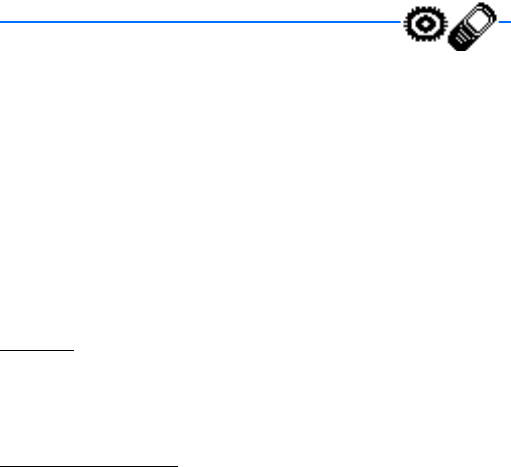
Settings
55
9. Settings
Use this menu to set or change profiles, tone settings, call settings, phone settings,
phone details, time and date settings, voice navigation, enhancement settings,
security settings, or to restore the factory settings.
■Profiles
Profiles define how your phone reacts when you receive a call or message, how
your keypad sounds when you press a key, and more. Ringing options, keypad tones,
and other settings for each of the available profiles can be customized or left at
their default setting. The following profiles are available: Normal, Silent, Meeting,
Outdoor, and Pager.
Profiles are also available for enhancements such as a headset and car kit.
See "Enhancement settings," page 66.
Activate
1. At the main screen, select Menu >Settings > Profiles.
2. Select the profile of your choice.
3. Select Activate.
Personalize a profile
You can personalize any of the profiles a variety of ways.
1. At the main screen, select Menu >Settings > Profiles.
2. Select the profile you wish to customize.
3. Select Customize.

Settings
56
4. Select the option you want to customize: Incoming call alert, Ringtone, Ringtone
volume, Vibrating alert, Light alert, Message alert tone, Keypad tones, Warning
tones, Alert for, or Profile name.
You cannot rename the Normal profile.
Select Alert for to set the phone to ring only upon calls from phone numbers that
belong to a selected caller group. Scroll to the caller group you want or All calls,
and select Mark or Unmark > Done. To set the phone to ring for every call, select
All calls > Mark > Done.
Changing your ringtone
Your can select from many ringtones, including your downloaded ringtones, that
appear in the list in your profiles.
1. From the main screen, select Menu >Settings > Profiles > Normal, Silent,
Meeting, Outdoor, or Pager.
2. Select Customize > Ringtone and select a ringtone from the list.
Set a timed profile
Timed profiles can be used to prevent missed calls. For example, you attend an event
that requires your phone be set to Silent before the event starts, but you forget to
return it to Normal until long after the event. A timed profile can prevent missed
calls by returning your phone to the default profile at a time you specify.
Timed profiles can be set up to 24 hours in advance.
1. At the main screen, select Menu >Settings > Profiles.
2. Select the profile you wish to activate.
3. Select Timed.
4. Enter the time for the profile to expire, and select OK.

Settings
57
■Tone settings
From this menu, you can adjust the ringtone volume, keypad tones, and other tone
settings for the currently active profile. You can also set the phone to ring for calls
from phone numbers that belong to a selected caller group. See "Personalize a
profile," page 55.
■Call settings
Location info sharing
Location info sharing is a network service. See "Network Services," page 7.
Location info sharing allows the phone to share position information over the network.
For calls to emergency numbers, this position information may be used by the
emergency operator to determine the position of the phone. The functionality and
accuracy of this feature is dependent on the network, satellite systems, and the
agency receiving the information. It may not function in all areas or at all times.
At the main screen, select Menu > Settings > Call settings > Location info sharing >
Emergency or On > OK > OK.
Emergency—This is the default profile. The phone location information is shared
only during an emergency call to the official emergency number programmed into
your phone. The phone screen displays in the main screen.
On—The phone location information is shared with the network whenever the
phone is powered on and activated. The screen displays in the main screen.
Location information is always shared with the network during emergency calls to
the official emergency number programmed into the phone, regardless of the setting
you select. After placing an emergency call, the phone remains in emergency mode
for five minutes. During this time, the location information is shared with the network.
See "Emergency calls," page 92.

Settings
58
Anykey answer
Anykey answer allows you to answer an incoming call by briefly pressing any key
except the Power key, Right selection key, or End key.
At the main screen, select Menu > Settings > Call settings > Anykey answer > On or Off.
Automatic redial
With automatic redial activated, your phone redials the number until the call is
successful, or is terminated.
At the main screen, select Menu > Settings > Call settings > Automatic redial >
On or Off.
Speed dialing
You can activate or deactivate speed dialing. At the main screen, select Menu >
Settings > Call settings > Speed dialing > On or Off. See "Speed dialing," page 31.
Calling card
If you use a calling card for long distance calls, you can save the calling card
numbers in your device. Your device can store up to four calling cards.
Save information
1. In standby mode, select Menu > Settings > Call settings > Calling card.
2. Enter your security code, and select OK.
3. Scroll to one of the four memory locations, and select Options > Edit >
Dialing sequence.
4. Select one of the following sequence types:
Access no. + phone no. + card no.—Dial the calling card access number, phone
number, card number, and PIN, if required.

Settings
59
Access no. + card no. + phone no.—Dial the calling card access number, card
number, PIN (if required), and phone number.
Prefix + phone no. + card no.—Dial the prefix (numbers that must precede the
phone number), phone number, card number, and PIN (if required).
5. Enter the required information (access number or prefix and card number), and
select OK to confirm your entries.
6. Select Card name.
7. Enter the card name, and select OK.
Contact your calling card company for more information.
Make calls
After you have saved your calling card information in your device, you can make a
call using your calling card.
1. In standby mode, select Menu > Settings > Call settings > Calling card.
2. Enter your security code, and select OK.
3. Scroll to the calling card of your choice, and select Options > Select > OK.
4. Press the end key to return to the standby screen; then enter the phone number,
including any prefix (such as 0 or 1) that your calling card may require when
you make a calling card call. See your calling card for instructions.
5. Press and hold the call key for a few seconds until Card call is displayed.
6. When you hear the tone or system message, select OK.
Call Summary
Your phone can display the time spent on a call when you hang up.
At the main screen, select Menu > Settings > Call settings > Call summary > On or Off.

Settings
60
■Phone settings
Phone language
1. At the main screen, select Menu > Settings > Phone settings > Phone language.
2. Select the language of your choice.
The language setting may affect the time and date formats of the clock, alarm
clock, and calendar.
Automatic keyguard
You can set the keypad of your phone to lock automatically after a preset time delay.
1. At the main screen, select Menu > Settings > Phone settings > Automatic
keyguard > On or Off.
2. If you select On, Set delay: is displayed.
3. Enter the delay time (in minutes and seconds), and select OK.
When keyguard is on, it may be possible to dial the emergency number
programmed into your phone.
Touch tones
Touch tones are the tones that sound when you press the keys on your phone
keypad. You can use touch tones for many automated dial-up services such as
banking and airlines or for entering your voicemail box number and password.
Touch tones are sent during an active call. You can send them manually from your
phone keypad, or send them automatically by saving them in your phone.
Set type
1. At the main screen, select Menu > Settings > Phone settings > Touch tones >
Manual Touch tones.

Settings
61
2. Select one of the following options:
Continuous—The tone sounds for as long as you press and hold a key.
Fixed—Used to send tones of the duration you specify in the Touch tone
length option.
Off—Used to turn off tones. No tones are sent when you press a key.
Set length
You can also specify touch tone length when using the Fixed option.
At the main screen, select Menu > Settings > Phone settings > Touch tones >
Touch tone length > Short (0.1 second) or Long (0.5 second).
Welcome note
You can write a welcome note which briefly appears on the screen whenever you
switch your phone on.
Predictive text input is not available for entering Welcome note text.
1. At the main screen, select Menu > Settings > Phone settings > Welcome note.
2. Enter a note (up to 44 characters).
Press * to display and select from available special characters.
3. When you are finished, select Options > Save.
Select Delete if you want to delete the previous text and begin creating another
welcome note.
My banner
You can choose whether the display shows Virgin Mobile’s logo or your own banner
in text when the phone is in the idle state.

Settings
62
At the main screen, select Menu > Settings > Phone settings >My banner >
Default or Customize.
Help text activation
Your phone displays brief descriptions for most menu items. When you arrive at a
feature or menu, pause for about 10 seconds, and wait for the help text to display.
Scroll through the full help text, if necessary.
The default setting for help text is on. However, you can turn help text on or off.
At the main screen, select Menu > Settings > Phone settings > Help text activation >
On or Off.
Display brightness
You can change the brightness of your phone display.
1. At the main screen, select Menu > Settings > Phone settings > Display brightness.
2. Scroll up and down to adjust the brightness level to your preference.
3. Select OK to accept your settings.
■Phone details
To view specific information about this phone, select Menu > Settings > Phone
details and one of the following:
Own number (MDN)—Displays the mobile directory number, or phone number.
Software version—Displays the current software version.
Browser version—Displays the current version of the minibrowser used with VirginXtras.

Settings
63
■Time and date settings
Clock
Show or hide the clock
At the main screen, select Menu > Settings > Time and date settings > Clock >
Show clock or Hide clock.
Set the time
1. At the main screen, select Menu > Settings > Time and date settings > Clock >
Set the time.
2. Enter the time in hh:mm format, and select OK.
3. Select am or pm (only when the 12-hour format is in use).
Change the format
At the main screen, select Menu > Settings > Time and date settings >Clock >
Time format > 24-hour or 12-hour.
Date
Show or hide the date
At the main screen, select Menu > Settings > Time and date settings >Date >
Show date or Hide date.
Set the date
1. At the main screen, select Menu > Settings > Time and date settings >Date >
Set the date.
2. Enter the date, and select OK.

Settings
64
Change the date format
At the main screen, select Menu > Settings > Time and date settings > Date > Date
format and the format of your choice.
Date separator
At the main screen, select Menu > Settings > Time and date settings > Date > Date
separator and the separator of your choice.
Set the auto-update
Auto-update is a network service. See "Network Services," page 7.
You can allow the digital network to set the clock, which is useful when you are out
of your home area (for example, when you travel to another network or time zone).
At the start screen, select Menu > Settings > Time and date settings > Auto-update
of date & time > On, Confirm first, or Off.
If you use the Auto-update of date & time option while outside your digital network,
you may be prompted to enter the time manually. Network time will replace the
time and date when you re-enter your digital network.
If your battery is removed or discharged outside the digital network, you may be
prompted to enter the time manually (when the battery is replaced or recharged
and you are still outside of the digital network).
■Voice navigation
Voice navigation allows you to quickly perform certain commands by speaking them,
instead of using the keypad to access them. For example, you can switch your profile,
call voicemail, playback a voice memo, or review recent calls by speaking the
recorded command.
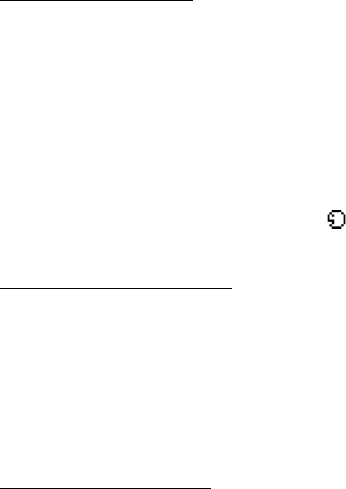
Settings
65
Add a voice command
Before using a voice command, you must add the command to the phone function
by recording it.
1. At the main screen, select Menu > Settings > Voice navigation.
2. Select the phone function you wish to tag: Profiles, Voice mailbox, Voice memo,
or Recent Calls.
3. If necessary, select an option associated with that function, and select
Options > Add command.
4. Select Start, and speak the voice command clearly into the phone.
Do not select Quit unless you want to cancel the recording.
The phone replays then saves the recorded command. appears next to functions
that have voice commands assigned.
Activate a voice command
After you have associated a voice command with a phone function, you can request
the function by speaking the voice command.
1. At the main screen, select and hold Contacts.
2. When Speak now appears, speak the voice command clearly into the phone.
When the phone finds the voice command, Found: appears, and the phone plays
the recognized voice command through the earpiece. The function you requested
is activated.
Voice command options
After you have associated a voice command with a function, select one of the
following options:
Playback—Listen to the voice command.

Settings
66
Change—Change the voice command.
Delete—Erase the voice command.
■Enhancement settings
The enhancement settings menu is shown only if the phone has been connected to
a compatible enhancement.
At the main screen, select Menu > Settings > Enhancement settings > Headset,
Handsfree, Loopset, or Charger and the desired accessory.
■Security settings
Phone lock
The phone lock feature protects your phone from unauthorized outgoing calls or
unauthorized access to information stored in the phone. When phone lock is activated,
Phone locked is displayed each time you turn your phone on.
When the phone is locked, calls still may be possible to the official emergency number
programmed into your phone.
1. At the main screen, select Menu > Settings > Security settings.
2. Enter the lock code, and select OK.
3. Select Phone lock and one of the following options:
Off—Immediately turns off the phone lock feature.
Lock now—Turns the phone lock feature on immediately.
On power-up—Turns the phone lock feature on immediately after the phone is
turned off and then on.
Call not allowed is displayed if you attempt to place a call while the phone is locked.

Settings
67
To answer a call with phone lock on, select Answer, or press Call.
Allowed phone number when phone locked
When phone lock is on, the only outgoing calls that can be made are to the emergency
number programmed into your phone (for example, 911 or other official emergency
number) or the number stored in the Allowed number when phone locked location.
1. At the main screen, select Menu > Settings > Security settings .
2. Enter the lock code, and select OK.
3. Select Allowed number when phone locked.
4. Enter the phone number and select Assign if the slot is emply; or select Options >
Change to change the phone number. Search, recall the number from the phone
book, and select OK.
Change the lock code
Tip: Avoid using codes similar to emergency numbers such as 911 to prevent
accidental dialing of the emergency number.
The lock code controls access to features and is supplied with the phone. The preset
lock code is the last four digits of your phone number. When you change the lock
code, keep the new code secret and in a safe place separate from your phone.
1. At the main screen, select Menu > Settings > Security settings.
2. Enter the current lock code (the default is the last four digits of your phone
number), and select OK.
3. Select Change lock code.
4. Enter the new lock code (4 characters), and select OK.
5. Reenter the new lock code for verification, and select OK.

Settings
68
Restrict calls
Call restriction is a network service. See "Network Services," page 7.
You can restrict the calls your phone can make and receive. When calls are
restricted, calls still may be possible to the official emergency number programmed
into your phone.
1. At the main screen, select Menu > Settings > Security settings.
2. Enter the lock code, and press OK.
3. Select Call restrictions and the types of calls you wish to restrict:
Restrict outgoing calls—Calls cannot be made.
Restrict incoming calls—Calls cannot be received.
4. Select one of the following options:
Select—Restricts a specific number or All calls. Select Mark to enable a restriction.
Add restriction—Enter a specific number and name, or select Search to enter a
number from the contacts list.
Edit—Allows you to edit previously entered restricted numbers.
Delete—Allows you to delete previously entered restricted numbers.
■Restore factory settings
You can reset some of the menu settings to their original values. Data that you
have entered or downloaded is not deleted (for example, entries in your contacts
list are not affected).
1. At the main screen, select Menu > Settings > Restore factory settings.
2. Enter the lock code (the default lock code is the last four digits of your
phone number), and select OK.
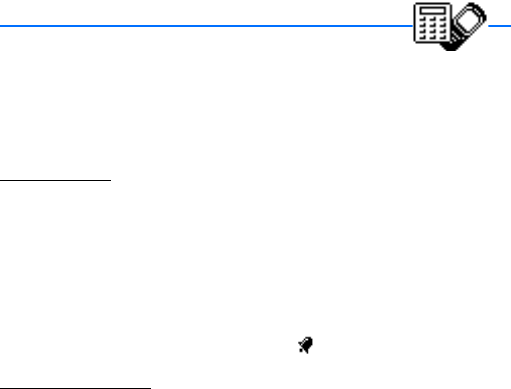
Tools
69
10. Tools
Your phone features some helpful tools, including an alarm clock, calendar, voice
memo, calculator, countdown clock, and stopwatch.
■Alarm clock
Set an alarm
The alarm clock is based on the phone clock. It sounds an alert any time you specify
and works even when the phone is turned off.
1. At the main screen, select Menu > Tools > Alarm clock. If the alarm has been
previously set, select On.
2. Enter the time for the alarm in hh:mm format, and select OK.
3. Select am or pm if 12-hour format has been selected.
Alarm on appears briefly in the display, and appears on the main screen.
Alarm conditions
When the alarm sounds, your phone beeps and/or vibrates (if vibrate alert is on in
the currently active profile), and lights up.
With the phone on, select Stop to shut the alarm off, or select Snooze. If you select
Snooze, the alarm stops for 10 minutes, and Snooze on is displayed.
If you do not press a key, the alarms stops after 1 minute and snoozes for 10 minutes,
then sounds again.

Tools
70
If the alarm time is reached while the phone is switched off, the phone switches itself
on and starts sounding the alarm tone. If you select Stop, the phone asks whether you
want to activate the phone for calls. Select No to switch off the phone or Yes to make
and receive calls. Do not select Yes when wireless phone use may cause interference
or danger.
Turn an alarm off
At the main screen, select Menu > Tools > Alarm clock > Off.
■Calendar
The calendar keeps track of reminders, calls you need to make, meetings, memos,
and birthdays. It can even sound an alarm for any of these events.
Monthly view provides an overview of the selected month and weeks. It also allows
you to jump to a specific date. Any days or dates that appear in bold font contain
calendar notes such as a meeting or reminder.
Open
At the main screen, select Menu > Tools > Calendar.
You can move the cursor in some calendar views with the scroll keys.
Go to a date
1. At the main screen, select Menu > Tools > Calendar > Options > Go to date.
2. Enter the date (for example, 07/15/2004), and select OK.
Note a specific date
Your phone asks for further information depending on the type of note you select.
You can also set an alarm for your note.
1. Go to the date for which you want to set a reminder. See "Go to a date," page 70.

Tools
71
2. From the monthly view, with the date highlighted, select Options > Make a note.
3. Select one of the following note types:
Meeting—You are prompted to enter a subject, location, and a start and end time.
You are then given the option to set an alarm.
Call—You are prompted to enter a phone number, a name, and the time. You are
then given the option to set an alarm.
Birthday—You are prompted to enter the person’s name and year of birth. You are
then given the option to set an alarm.
Memo—You are prompted to enter a subject and an end date. You are then given
the option to set an alarm.
Reminder—You are prompted to enter the subject of the reminder. You are then
given the option to set an alarm.
4. Enter your note, and select Options > Save.
View notes (day view)
After you have created some calendar notes, you can view them as follows:
1. At the main screen, select Menu > Tools > Calendar.
2. Scroll to the date containing the note.
Any days containing notes will be in bold type.
3. Select Options > View day.
4. To view a highlighted note, select Options > View.
Options while viewing a list of notes
Select Options while viewing a list of a day’s notes and one of the following:
The options listed below are available while viewing the title of a note.
View—View the full note.
Tools
72
Make a note—Create a new note for the selected date.
Delete—Delete the note.
Edit—Edit the note.
Move—Move the note to another date on your calendar.
Repeat—Enable the note to recur on a regular basis. Select Every day, Every week,
Every 2 weeks, Every month, Every year, or Not repeated.
Tip: Repeat is not available for Birthday note.
Go to date—Jump to another date on your calendar.
Send note—Send the note to another phone using text message, or in calendar format.
Copy—Copy the note. You can then paste the note to another date.
Settings—Set the date and time, format, the day each week starts, and whether you
want your notes to auto-delete after a specified time.
Send a note
You can send a calendar note to another compatible phone. Multiple text messaging
charges may apply. Check with Virgin Mobile for details.
1. At the main screen, select Menu > Tools > Calendar.
2. Scroll to the date containing the note you wish to send.
Any days containing notes will be in bold type.
3. Select Options > View day.
4. Select the note you wish to send and Options > Send note > Via calendar or
Via text msg.
5. If you select Via calendar, enter the number for the recipient; or select Search
to retrieve a number from the contacts list and OK. The note is sent.
6. If you select Via text msg., select Add number.

Tools
73
7. Enter the number for the recipient; or select Search to retrieve a number from
the contacts list and OK.
8. Select Options > Send.
Receive notes
When you receive a calendar note, your phone displays notification that the calendar
note arrived. Save the note in your calendar, and set an alarm for any date and time.
View notes
1. When your phone displays notification that the calendar note arrived, select Show.
2. Scroll to view the entire message, if necessary.
Save notes
After viewing the calendar note, select Options > Save.
Discard notes
After viewing the calendar note, select Options > Discard.
■Voice memo
This feature allows you to record a speech or sound memo with your phone and
listen to it later. The total available time is 60 seconds if no memos have been
stored. The maximum length of a recording depends on how much memory remains
available. The recorder cannot be used when you are using VirginXtras.
Record speech or sound
1. At the main screen, select Menu > Tools > Voice memo > Record.
2. After the recorder start tone is heard, begin recording speech or sound.
3. When you are finished recording, select Stop.
4. Type in a name for the recording, and select OK. The recording is saved to the
recording list.

Tools
74
Record list options
1. When you have saved a recording, at the main screen, select Menu > Tools >
Voice memo > Recordings list.
2. Scroll through the list to find your recording; then, select Options and one of
the following:
Playback—Listen to the recording using the earpiece.
Delete—Erase the recording.
Edit title—Rename the recording.
Add alarm—Add an alarm to the recording.
■Calculator
The calculator on your phone adds, subtracts, multiplies, divides, calculates the
square and the square root, changes the sign of the number entered, and converts
currency values.
This calculator has a limited accuracy and is designed for simple calculations.
1. At the main screen, select Menu > Tools > Calculator.
2. Enter the first number in the calculation.
Press # for a decimal point if necessary.
Press * to cycle through the add (+), subtract (-), multiply (*), and divide (/)
characters. Pause briefly to select the displayed character.
3. Enter the second number in your calculation.
4. Select Options (equals is highlighted).
To perform a square or square root calculation, select Options > Square or Square
root. Select Options > Change sign to change the sign of your result.

Tools
75
Currency converter
You can convert foreign currency to domestic or vice versa.
1. At the main screen, enter a currency amount to convert.
2. Select Options > To home or To foreign.
To home—converts foreign currency to domestic currency.
To foreign—converts domestic currency to foreign currency.
If you have not done so already, you are prompted to enter the exchange rate.
3. Enter the exchange rate (press # to insert a decimal), and select OK.
You can also edit the exchange rate at any time.
When you change base currency, you must enter the new rates because all
previously set exchange rates are set to zero.
1. At the main screen, select Menu > Tools > Calculator > Options > Exchange
rate > Foreign unit expressed in domestic units or Domestic unit expressed in
foreign units.
Foreign unit expressed in domestic units—The number of home units it takes to
make one unit of foreign currency.
Domestic unit expressed in foreign units—The number of foreign units it takes
to make one unit of your home currency.
2. Enter the exchange rate, and select OK.
■Countdown timer
You can enter a specified time (up to 99 hours and 59 minutes). When the time
runs out, your phone sounds an alarm.
The countdown timer only works when the phone is on. When you turn off your
phone, the timer is no longer active.
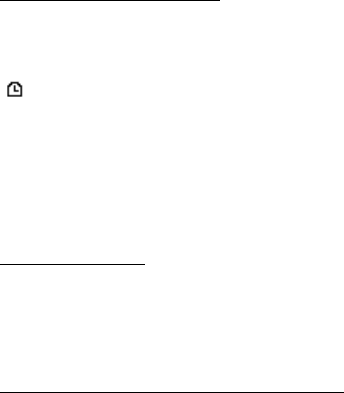
Tools
76
Set the countdown timer
1. At the main screen, select Menu > Tools > Countdown timer.
2. Enter the time (in hh:mm format), and OK.
3. Enter a note for the timer, and OK.
appears on the main screen when the countdown timer is set.
When the timer runs out, your phone sounds an alarm and flashes its lights. The timer
note is displayed on the main screen. If you are using a phone function when the
alarm sounds, the timer note is displayed when you return to the main screen.
• Press any key during the alarm to stop the timer.
• At the main screen, select OK to clear the timer note.
• After 60 seconds the timer alert stops automatically.
Change the time
After you have set the timer, you can change the time.
1. At the main screen, select Menu > Tools > Countdown timer > Change time.
2. Enter the new time, and select OK.
3. Leave the note as it was; or enter a new note, and select OK.
Stop the timer before the alarm sounds
After you have set the timer, you can stop the timer.
At the main screen, select Menu > Tools > Countdown timer > Stop timer.
■Stopwatch
Your phone has a stopwatch that can be used to track time. The stopwatch displays
time in hours, minutes, seconds, and fractions of a second in hh:mm:ss:s format.
Using the stopwatch or allowing it to run in the background when using other
features increases the demand on battery power and reduces the battery life.

Tools
77
Split or Lap time
Use the split time function for such things as a long distance race when you need
to pace yourself.
1. At the main screen, select Menu > Tools > Stopwatch > Split timing or Lap
timing > Start.
Split timing—You can use the split time function to pace yourself as you might do
during a race. Select Split to note the lapsed time. The timer continues to run
and the split time appears below the running time. Each time you select Split,
the new measured time appears at the beginning of the list.
Lap timing—You can use the lap time function to track how long it takes to
complete a cycle or lap. Select Lap to note the lap time. The timer stops, then
immediately returns to zero for the next lap. The lap time appears below the
running time. Each time you select Lap, the new measured time appears at the
beginning of the list.
2. Select Stop to end timing and display total time.
Save, view or delete split and lap times
• To save a time while the timer is running select Stop > Save, enter a name for
the measurement, and select OK. If you do not enter a name, the total time is
used as the default title for the lap or split time.
• To view the last measured time, from the main screen, select Menu > Tools >
Stopwatch > Split timing or Lap timing > Show last time.
• To browse saved times, from the main screen, select Menu > Tools > Stopwatch
> Split timing or Lap timing > View times.
• To delete a saved time, from Stopwatch, select View times > Select > Delete or
select Delete times > One by one or Delete all.

Tools
78
Operation note
If you press End and return to the main screen, the timer continues to run in the
background, and appears in the upper left corner of the screen.
To return to the stopwatch, do the following:
1. At the main screen, select Menu > Tools > Stopwatch >Continue.
2. To stop the timer, select Stop.

Games
79
11. Games
Challenge yourself to one of the fun games on your phone.
Some menus listed are network services. Contact Virgin Mobile for more information.
■Game settings
At the main screen, select Menu > Games > Settings > Game sounds, Game lights,
or Shakes.
■Play a game
1. At the main screen, select Menu > Games > Select game.
2. Select a game.
3. Options and submenus vary with each game. Select one of the following
options, if supported by the game:
New game—Launches a new game.
High scores—View the high scores for this game (if previously played).
Instructions—View instructions for playing the game. Select More for
more information.
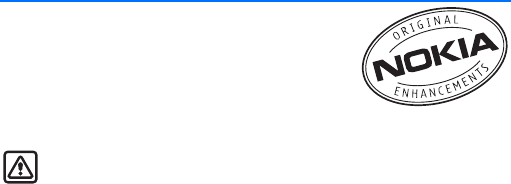
Enhancements
80
12. Enhancements
Check the model number of any charger before use with
this phone. This phone is intended for use when
supplied with power from a Nokia ACP-12U, Nokia
ACP-12, Nokia AC-1, or Nokia LCH-12 charger.
Your phone contains a Standard 1070-mAh Li-Ion Battery (BL-6C).
Warning: Use only batteries, chargers and enhancements approved by
Nokia for use with this particular model. The use of any other types may
invalidate any approval or warranty, and may be dangerous. For
availability of approved enhancements, please check with your dealer.
A few practical rules about accessories and enhancements:
• Keep all accessories and enhancements out of the reach of small children.
• When you disconnect the power cord of any accessory or enhancement, grasp
and pull the plug, not the cord.
• Check regularly that enhancements installed in a vehicle are mounted and are
operating properly.
• Installation of any complex car enhancements must be made by qualified
personnel only.
Power
• Standard 1070-mAh Li-Ion Battery (BL-6C)
• Standard Charger (ACP-12U)
• Travel Charger (ACP-12)
• Retractable Charger (AC-1)
• Mobile Charger (LCH-12)

Enhancements
81
Headset and Audio
• Boom Headset (HDB-4)
• Ear Bud Headset (HS-5)
• Retractable Headset (HS-10)
• Inductive Loopset (LPS-4)
Car and Desk Stand
• Desk Stand (DCV-14)
• Easy-to-use Handsfree (HF-3)
• Headrest Handsfree (BHF-3)
Miscellaneous
• Data Cable (CA-42)
• Xpress-on Color Covers
• Carry Case
See www.nokia.com/phones for more information about enhancements.
■Hearing aid compatibility
Your mobile device model complies with FCC rules governing hearing aid
compatibility. These rules require an M3 microphone or higher value. The M–value,
shown on the device box, refers to lower radio frequency (RF) emissions. A higher
M-value generally indicates that a device model has a lower RF emissions level,
which may improve the likelihood that the device will operate with certain hearing
aids. Some hearing aids are more immune than others are to interference. Please
consult your hearing health professional to determine the M–rating of your
hearing aid and whether your hearing aid will work with this device. More
information on accessibility can be found at www.nokiaaccessibility.com.

Purchasing accessories
82
13. Purchasing accessories
To purchase accessories for your new phone such as a hands-free headset, carrying
case, or car power adapter, please visit www.virginmobileusa.com.

Battery information
83
14. Battery information
This section provides information about batteries, chargers, safety guidelines and
technical information. Be aware that the information in this section is subject to
change as batteries and chargers change.
■Charging and discharging batteries
Your phone is powered by a rechargeable battery. The full performance of a new
battery is achieved only after two or three complete charge and discharge cycles.
The battery can be charged and discharged hundreds of times but it will eventually
wear out. When the talk and standby times are noticeably shorter than normal,
replace the battery. Use only Nokia approved batteries, and recharge your battery
only with Nokia approved chargers designated for this phone.
Unplug the charger from the electrical plug and the phone when not in use. Do not
leave a fully charged battery connected to a charger, since overcharging may shorten
its lifetime. If left unused, a fully charged battery will lose its charge over time.
Use the battery only for its intended purpose. Never use any charger or battery that
is damaged.
Do not short-circuit the battery. Accidental short-circuiting can occur when a
metallic object such as a coin, clip, or pen causes direct connection of the positive
(+) and negative (-) terminals of the battery. (These look like metal strips on the
battery.) This might happen, for example, when you carry a spare battery in your
pocket or purse. Short-circuiting the terminals may damage the battery or the
connecting object.
Battery information
84
Leaving the battery in hot or cold places, such as in a closed car in summer or winter
conditions, will reduce the capacity and lifetime of the battery and its ability to charge.
Always try to keep the battery between 59°F and 77°F (15°C and 25°C). A phone with
a hot or cold battery may not work temporarily, even when the battery is fully charged.
Battery performance is particularly limited in temperatures well below freezing.
Do not dispose of batteries in a fire, as they may explode. Batteries may also explode
if damaged. Dispose of batteries according to local regulations. Please recycle when
possible. Do not dispose as household waste.
■Nokia battery authentication guidelines
Always use original Nokia batteries for your safety. To check that you are getting
an original Nokia battery, purchase it from an authorized Nokia dealer, look for the
Nokia Original Enhancements logo on the packaging and inspect the hologram
label using the following steps:
Successful completion of the four steps is not a total assurance of the authenticity
of the battery. If you have any reason to believe that your battery is not an authentic
original Nokia battery, you should refrain from using it and take it to the nearest
authorized Nokia service point or dealer for assistance. Your authorized Nokia
service point or dealer will inspect the battery for authenticity.
If authenticity cannot be verified, return the battery to the place of purchase.
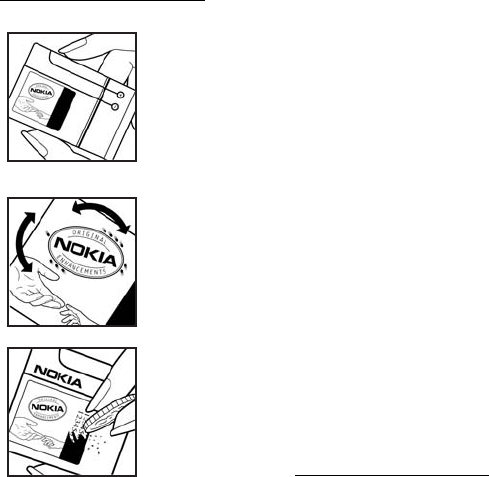
Battery information
85
Authenticate hologram
1. When looking at the hologram label, you should see
the Nokia connecting hands symbol from one angle
and the Nokia Original Enhancements logo when
looking from another angle.
2. When you angle the hologram to the left, right,
down, and up sides of the logo, you should see 1, 2,
3, and 4 dots on each side respectively.
3. Scratch the side of the label to reveal a 20-digit
code, for example, 12345678919876543210. Turn
the battery so that the numbers are facing upwards.
The 20-digit code reads starting from the number at
the top row followed by the bottom row.
4. Confirm that the 20-digit code is valid by following
the instructions at www.nokia.com/batterycheck.

Battery information
86
What if your battery is not authentic?
If you cannot confirm that your Nokia battery with the hologram label is an authentic
Nokia battery, please do not use the battery. Take it to the nearest authorized Nokia
service point or dealer for assistance. The use of a battery that is not approved by the
manufacturer may be dangerous and may result in poor performance and damage
to your phone and its enhancements. It may also invalidate any approval or warranty
applying to the phone.
To find out more about original Nokia batteries visit www.nokia.com/battery.
■Charging times
The following charging times are approximate with the BL-6C 1070 mAh
Li-Ion battery:
Travel Charger (ACP-12): up to 1 hour 45 minutes
Standard Travel Charger (ACP-12U): up to 3 hours 45 minutes
■Talk and standby times
Operation times are estimates only and depend on signal strength, network
conditions, user habits (phone use, features used, and number of idle hand-off),
battery age and condition (including charging habits), temperatures to which the
battery is exposed, and many other factors.
Talk time: 3.7 up to 4.6 hours
Standby time: 139 up to 212 hours

Care and maintenance
87
Care and maintenance
Your phone is a product of superior design and craftsmanship and should be treated
with care. The suggestions below help you to protect your warranty coverage.
• Keep the phone and all of its parts and accessories out of the reach of
small children.
• Keep the phone dry. Precipitation, humidity and all types of liquids or moisture can
contain minerals that will corrode electronic circuits. If your phone does get wet,
remove the battery and allow the phone to dry completely before replacing it.
• Do not use or store the phone in dusty, dirty areas. Its moving parts and
electronic components can be damaged.
• Do not store the phone in hot areas. High temperatures can shorten the life of
electronic phones, damage batteries, and warp or melt certain plastics.
• Do not store the phone in cold areas. When the phone returns to its normal
temperature, moisture can form inside the phone and damage electronic
circuit boards.
• Do not attempt to open the phone other than as instructed in this guide.
• Do not drop, knock, or shake the phone. Rough handling can break internal
circuit boards and fine mechanics.
• Do not use harsh chemicals, cleaning solvents, or strong detergents to clean
the phone.
• Do not paint the phone. Paint can clog the moving parts and prevent
proper operation.

Care and maintenance
88
• Use only the supplied or an approved replacement antenna. Unauthorized
antennas, modifications, or attachments could damage the phone and may
violate regulations governing radio phones.
• Use chargers indoors.
All of the above suggestions apply equally to your phone, battery, charger, or any
enhancement. If any phone is not working properly, take it to the nearest
authorized service facility for service.
Note: Before sending your phone to a service facility, create a backup of
data you want to keep such as contacts and calendar notes.

Additional safety information
89
Additional safety information
■Operating environment
This device meets RF exposure guidelines when used either in the normal use
position against the ear or when positioned at least 2.2cm (7/8 inches) away from
the body. When a carry case, belt clip or holder is used for body-worn operation, it
should not contain metal and should position the device the above stated distance
from your body.
In order to transmit data files or messages, this device requires a good quality
connection to the network. In some cases, transmission of data files or messages
may be delayed until such a connection is available. Ensure the above separation
distance instructions are followed until the transmission is completed.
■Medical devices
Operation of any radio transmitting equipment, including wireless phones, may
interfere with the functionality of inadequately protected medical devices. Consult
a physician or the manufacturer of the medical device to determine if they are
adequately shielded from external RF energy or if you have any questions. Switch
off your phone in health care facilities when any regulations posted in these areas
instruct you to do so. Hospitals or health care facilities may be using equipment
that could be sensitive to external RF energy.
Additional safety information
90
PACEMAKERS
Pacemaker manufacturers recommend that a minimum separation of 6 inches
(15.3 cm) be maintained between a wireless phone and a pacemaker to avoid potential
interference with the pacemaker. These recommendations are consistent with the
independent research by and recommendations of Wireless Technology Research.
To minimize the potential for interference, persons with pacemakers should
• Always keep the phone more than 6 inches (15.3 cm) from their pacemaker
when the phone is switched on
• Not carry the phone in a breast pocket
• Hold the phone to the ear opposite the pacemaker to minimize the potential
for interference
If you have any reason to suspect that interference is taking place, switch off your
phone immediately.
HEARING AIDS
Some digital wireless phones may interfere with some hearing aids. If interference
occurs, consult your service provider.
■Vehicles
RF signals may affect improperly installed or inadequately shielded electronic systems
in motor vehicles such as electronic fuel injection systems, electronic antiskid
(antilock) braking systems, electronic speed control systems, air bag systems. For
more information, check with the manufacturer or its representative of your vehicle
or any equipment that has been added.
Only qualified personnel should service the phone, or install the phone in a vehicle.
Faulty installation or service may be dangerous and may invalidate any warranty that
may apply to the phone. Check regularly that all wireless phone equipment in your
vehicle is mounted and operating properly. Do not store or carry flammable liquids,
Additional safety information
91
gases, or explosive materials in the same compartment as the phone, its parts, or
enhancements. For vehicles equipped with an air bag, remember that an air bag
inflates with great force. Do not place objects, including installed or portable wireless
equipment in the area over the air bag or in the air bag deployment area. If in-vehicle
wireless equipment is improperly installed and the air bag inflates, serious injury
could result.
■Potentially explosive environments
Switch off your phone when in any area with a potentially explosive atmosphere and
obey all signs and instructions. Potentially explosive atmospheres include areas where
you would normally be advised to turn off your vehicle engine. Sparks in such areas
could cause an explosion or fire resulting in bodily injury or even death. Switch off
the phone at refueling points such as near gas pumps at service stations. Observe
restrictions on the use of radio equipment in fuel depots, storage, and distribution
areas, chemical plants or where blasting operations are in progress. Areas with a
potentially explosive atmosphere are often but not always clearly marked. They
include below deck on boats, chemical transfer or storage facilities, vehicles using
liquefied petroleum gas (such as propane or butane), and areas where the air contains
chemicals or particles such as grain, dust or metal powders.
FCC regulations prohibit using your wireless device while in the air. The use of wireless
telephones in an aircraft may be dangerous to the operation of the aircraft, disrupt
the wireless telephone network, and may be illegal.
Failure to observe these instructions may lead to suspension or denial of telephone
services to the offender, legal action, or both.

Additional safety information
92
■Emergency calls
Important: Wireless phones, including this phone, operate using radio
signals, wireless networks, landline networks, and user-programmed
functions. Because of this, connections in all conditions cannot be
guaranteed. You should never rely solely on any wireless phone for
essential communications like medical emergencies.
To make an emergency call, do the following:
1. If the phone is not on, switch it on. Check for adequate signal strength.
2. Press End as many times as needed to clear the display and ready the
phone for calls.
3. Enter the official emergency number for your present location. Emergency
numbers vary by location.
4. Press Call.
If certain features are in use, you may first need to turn those features off before you
can make an emergency call. If the phone is in an offline or flight mode, you must
change the profile to activate the phone function before you can make an emergency
call. Consult this guide or your service provider. When making an emergency call,
give all the necessary information as accurately as possible. Your wireless phone
may be the only means of communication at the scene of an accident. Do not end
the call until given permission to do so.
Additional safety information
93
■Certification Information (SAR)
THIS MOBILE DEVICE MEETS GUIDELINES FOR EXPOSURE TO RADIO WAVES.
Your mobile device is a radio transmitter and receiver. It is designed not to exceed
the limits for exposure to radio waves recommended by international guidelines.
These guidelines were developed by the independent scientific organization ICNIRP
and include safety margins designed to assure the protection of all persons,
regardless of age and health.
The exposure guidelines for mobile devices employ a unit of measurement known
as the Specific Absorption Rate or SAR. The SAR limit stated in the ICNIRP
guidelines is 2.0 watts/kilogram (W/kg) averaged over ten grams of tissue. Tests for
SAR are conducted using standard operating positions with the device transmitting
at its highest certified power level in all tested frequency bands. The actual SAR
level of an operating device can be below the maximum value because the device is
designed to use only the power required to reach the network. That amount
changes depending on a number of factors such as how close you are to a network
base station. The highest SAR value under the ICNIRP guidelines for use of the
device at the ear is x.xx W/kg.
Use of device accessories and enhancements may result in different SAR values.
SAR values may vary depending on national reporting and testing requirements
and the network band. Additional SAR information may be provided under product
information at www.nokia.com.
Your mobile device is also designed to meet the requirements for exposure to radio
waves established by the Federal Communications Commission (USA) and Industry
Canada. These requirements set a SAR limit of 1.6 W/kg averaged over one gram of
tissue. The highest SAR value reported under this standard during product
certification for use at the ear is 1.12 W/kg and when properly worn on the body is
0.56 W/kg. Information about this device model can be found at http://
Additional safety information
94
www.fcc.gov/oet/fccid by searching the equipment authorization system using
FCC ID: QMNRH-89.
The exposure guidelines for mobile devices employ a unit of measurement known
as the Specific Absorption Rate or SAR. The SAR limit stated in the international
guidelines is 2.0 watts/kilogram (W/kg) averaged over 10 grams of tissue. Tests for
SAR are conducted using standard operating positions with the device transmitting
at its highest certified power level in all tested frequency bands. The actual SAR
level of an operating device can be well below the maximum value because the
device is designed to use only the power required to reach the network. That
amount changes depending on a number of factors such as how close you are to a
network base station. The highest SAR value when tested according to
international testing procedures for use at the ear for device type RH-89 is 0.75 W/
kg. The device type is listed on the label located under the battery.
SAR values may vary depending on national reporting and testing requirements
and the network band. Use of device accessories and enhancements may result in
different SAR values. Additional SAR information may be provided under product
information at www.nokia.com.
USA and Canada: The SAR limit of USA (FCC) and Canada (IC) is 1.6 W/kg averaged
over one gram of tissue. Device type RH-89 has also been tested against this SAR
limit. The highest SAR value reported under this standard during product
certification for use at the ear is 1.20 W/kg and when properly worn on the body is
1.13 W/kg. Information about this device can be found on the FCC's website at
www.fcc.gov/oet/fccid by searching the equipment authorization system using
FCC ID: QMNRH-89.

Additional safety information
95
■Technical information
■Patent information
Manufactured or sold under one or more of the following US patents:
Feature Specification
Dimensions Width 42.2 mm
Length 102.4 mm
Depth 21.5 mm
Weight 88 g with BL-6C Li-Ion Battery
Wireless networks CDMA 1900
Volume 70 cc
Frequency range (Tx) PCS: 1851.25–1908.75 MHz
Frequency Range (Rx) PCS: 1931.25–1988.75 MHz
GPS 1575.42 MHz
5889770 6148209 6072787 5802465 5596571
6128322 5991627 5699482 4969192 5754976
5701392 5859843 6078570 5924026 6510148
6009328 5930233 5793744 6556824 6775548
Additional safety information
96
■Nokia one-year limited warranty
Nokia Inc. (“Nokia”) warrants that this cellular phone (“Product”) is free from defects
in material and workmanship that result in Product failure during normal usage,
according to the following terms and conditions:
1. The limited warranty for the Product extends for ONE (1) year beginning on the
date of the purchase of the Product. This one year period is extended by each
whole day that the Product is out of your possession for repair under this warranty.
2. The limited warranty extends only to the original purchaser (“Consumer”) of
the Product and is not assignable or transferable to any subsequent purchaser/
end-user.
3. The limited warranty extends only to Consumers who purchase the Product in
the United States of America.
4. During the limited warranty period, Nokia will repair, or replace, at Nokia’s sole
option, any defective parts, or any parts that will not properly operate for their
intended use with new or refurbished replacement items if such repair or
replacement is needed because of product malfunction or failure during normal
usage. No charge will be made to the Consumer for any such parts. Nokia will also
pay for the labor charges incurred by Nokia in repairing or replacing the defective
parts. The limited warranty does not cover defects in appearance, cosmetic,
decorative or structural items, including framing, and any non-operative parts.
Nokia’s limit of liability under the limited warranty shall be the actual cash value
of the Product at the time the Consumer returns the Product for repair, determined
by the price paid by the Consumer for the Product less a reasonable amount for
usage. Nokia shall not be liable for any other losses or damages. These remedies
are the Consumer’s exclusive remedies for breach of warranty.
5. Upon request from Nokia, the Consumer must prove the date of the original
purchase of the Product by a dated bill of sale or dated itemized receipt.
Additional safety information
97
6. The Consumer shall have no coverage or benefits under this limited warranty if
any of the following conditions are applicable:
a) The Product has been subjected to abnormal use, abnormal conditions,
improper storage, exposure to moisture or dampness, unauthorized
modifications, unauthorized connections, unauthorized repair, misuse,
neglect, abuse, accident, alteration, improper installation, or other acts
which are not the fault of Nokia, including damage caused by shipping.
b) The Product has been damaged from external causes such as collision with
an object, or from fire, flooding, sand, dirt, windstorm, lightning, earthquake
or damage from exposure to weather conditions, an Act of God, or battery
leakage, theft, blown fuse, or improper use of any electrical source, damage
caused by computer or Internet viruses, bugs, worms, Trojan Horses, cancelbots
or damage caused by the connection to other products not recommended
for interconnection by Nokia.
c) Nokia was not advised in writing by the Consumer of the alleged defect or
malfunction of the Product within fourteen (14) days after the expiration of
the applicable limited warranty period.
d) The Product serial number plate or the enhancement data code has been
removed, defaced or altered.
e) The defect or damage was caused by the defective function of the cellular
system or by inadequate signal reception by the external antenna, or viruses
or other software problems introduced into the Product.
7. Nokia does not warrant uninterrupted or error-free operation of the Product. If
a problem develops during the limited warranty period, the Consumer shall take
the following step-by-step procedure:
a) The Consumer shall return the Product to the place of purchase for repair or
replacement processing.
Additional safety information
98
b) If “a” is not convenient because of distance (more than 50) or for other good
cause, the Consumer shall ship the Product prepaid and insured to Nokia.
See www.nokiausa.com/support for the address of the repair center
nearest you.
c) The Consumer shall include a return address, daytime phone number and/or
fax number, complete description of the problem, proof of purchase and
service agreement (if applicable). Expenses related to removing the Product
from an installation are not covered under this limited warranty.
d) The Consumer will be billed for any parts or labor charges not covered by
this limited warranty. The Consumer will be responsible for any expenses
related to reinstallation of the Product.
e) Nokia will repair the Product under the limited warranty within 30 days after
receipt of the Product. If Nokia cannot perform repairs covered under this
limited warranty within 30 days, or after a reasonable number of attempts
to repair the same defect, Nokia at its option, will provide a replacement
Product or refund the purchase price of the Product less a reasonable amount
for usage. In some states the Consumer may have the right to a loaner if the
repair of the Product takes more than ten (10) days. Please contact the
Customer Service Center at Nokia at the telephone number listed at the end
of this warranty if you need a loaner and the repair of the Product has taken
or is estimated to take more than ten (10) days.
f) If the Product is returned during the limited warranty period, but the problem
with the Product is not covered under the terms and conditions of this limited
warranty, the Consumer will be notified and given an estimate of the charges
the Consumer must pay to have the Product repaired, with all shipping charges
billed to the Consumer. If the estimate is refused, the Product will be returned
freight collect. If the Product is returned after the expiration of the limited
Additional safety information
99
warranty period, Nokia’s normal service policies shall apply and the Consumer
will be responsible for all shipping charges.
8. You (the Consumer) understand that the product may consist of refurbished
equipment that contains used components, some of which have been
reprocessed. The used components comply with Product performance and
reliability specifications.
9. ANY IMPLIED WARRANTY OF MERCHANTABILITY, OR FITNESS FOR A PARTICULAR
PURPOSE OR USE, SHALL BE LIMITED TO THE DURATION OF THE FOREGOING
LIMITED WRITTEN WARRANTY. OTHERWISE, THE FOREGOING LIMITED WARRANTY
IS THE CONSUMER’S SOLE AND EXCLUSIVE REMEDY AND IS IN LIEU OF ALL
OTHER WARRANTIES, EXPRESS OR IMPLIED. NOKIA SHALL NOT BE LIABLE FOR
SPECIAL, INCIDENTAL, PUNITIVE OR CONSEQUENTIAL DAMAGES, INCLUDING
BUT NOT LIMITED TO LOSS OF ANTICIPATED BENEFITS OR PROFITS, LOSS OF
SAVINGS OR REVENUE, LOSS OF DATA, PUNITIVE DAMAGES, LOSS OF USE OF
THE PRODUCT OR ANY ASSOCIATED EQUIPMENT, COST OF CAPITAL, COST OF
ANY SUBSTITUTE EQUIPMENT OR FACILITIES, DOWNTIME, THE CLAIMS OF ANY
THIRD PARTIES, INCLUDING CUSTOMERS, AND INJURY TO PROPERTY, RESULTING
FROM THE PURCHASE OR USE OF THE PRODUCT OR ARISING FROM BREACH OF
THE WARRANTY, BREACH OF CONTRACT, NEGLIGENCE, STRICT TORT, OR ANY
OTHER LEGAL OR EQUITABLE THEORY, EVEN IF NOKIA KNEW OF THE LIKELIHOOD
OF SUCH DAMAGES. NOKIA SHALL NOT BE LIABLE FOR DELAY IN RENDERING
SERVICE UNDER THE LIMITED WARRANTY, OR LOSS OF USE DURING THE PERIOD
THAT THE PRODUCT IS BEING REPAIRED.
Additional safety information
100
10. Some states do not allow limitation of how long an implied warranty lasts, so the
one year warranty limitation may not apply to you (the Consumer). Some states
do not allow the exclusion or limitation of incidental and consequential damages,
so certain of the above limitations or exclusions may not apply to you (the
Consumer). This limited warranty gives the Consumer specific legal rights and
the Consumer may also have other rights which vary from state to state.
11. Nokia neither assumes nor authorizes any authorized service center or any other
person or entity to assume for it any other obligation or liability beyond that
which is expressly provided for in this limited warranty including the provider
or seller of any extended warranty or service agreement.
12. This is the entire warranty between Nokia and the Consumer, and supersedes
all prior and contemporaneous agreements or understandings, oral or written,
relating to the Product, and no representation, promise or condition not contained
herein shall modify these terms.
13. This limited warranty allocates the risk of failure of the Product between the
Consumer and Nokia. The allocation is recognized by the Consumer and is
reflected in the purchase price.
14. Any action or lawsuit for breach of warranty must be commenced within
eighteen (18) months following purchase of the Product.
15. Questions concerning this limited warranty may be directed to:
Nokia Inc.
Telephone: 1-888-NOKIA-2U (1-888-665-4228)
Facsimile: (813) 249-9619
TTY/TDD Users Only: 1-800-24-NOKIA (1-800-246-6542)
www.nokiausa.com/support

Index
101
Index
A
alarm clock 75
antenna 17
anykey answer 63
automate voicemail 51
automatic redial 63
auto-update 70
B
back cover
removing 18
replacing 19
banner 67
battery
authentication 90
charging 19
charging times 92
removing 18
replacing 18
talk and standby times 92
battery information 89
business cards 38
C
calculator 80
calendar 76
call settings 62
caller groups 35
setting up 35
calling cards 63
calls
answering 23
in-call options 24
making 22
care and maintenance 93
certification information (SAR) 99
charger
connecting 19
times 92
check balance 39
contact information 29
contact name 30
contacts 28
contacts list
add 28
additions 30
delete 30
edit 36
search 28
settings 31
countdown timer 82
currency converter 81
customer care 9
D
dialing codes 52
display language 65
Index
102
download ringtone 55
E
edit
contact name 30
emergency calls 98
while using VirginXtras 55
with keypad locked 66
enhancement settings 72
enhancements 86
ESN 8
exchange rate 81
exit VirginXtras 56
F
FCC information 99
flashlight instructions 24
G
games 85
H
headset 20
hearing aid compatibility 87
help 8
help text 16, 67
I
incoming calls 58
indicators and icons 12
K
Keyguard 24
keyguard
automatic 65
L
languages 65
lap time 83
location info sharing 62
lock code 72
change 73
loudspeaker 23
M
main screen 12
message folders 46
messages
delete 49
text messages 40
voice messages 50
my account 39
my banner 67
my phone no. 35
N
Network services 7
O
outgoing calls 58
Index
103
P
patent information 101
phone lock 72
numbers allowed 73
phone settings 65
predictive text 26
profiles 60
Q
quick keys 12
R
recent calls 57
restore factory settings 74
restrict calls 74
ringtone, download 55
S
safety 5
important safety information 95
save
addresses and notes 29
numbers, text items, details 29
scrolling 14
security settings 72
set
date 69
time 68
settings 60
call 62
shared memory 8
shortcuts 15
speakerphone 23
speed dial 31
speed dialing 63
split time 83
standby time 92
stopwatch 83
T
talk and standby times 92
talk time 92
technical information 101
template 41
text entry 25
text message
template 41
text messages 40
time and date settings 68
timed profiles 61
tone settings 62
tools 75
top-up the account 39
touch tones 66
set length 66
set type 66
turn phone off 19
turn phone on 19
V
view
call times 58
incoming calls 58
Index
104
missed calls 57
saved messages 46
Virgin Alerts 50
VirginXtras 54
exit 56
make an emergency call 55
sign on 54
voice commands 70
voice dialing 32
voice messages 50
voice navigation 70
voice tags 32
assign a tag 33
options 33
voicemail
automate 51
voicemail set up 51
volume
adjusting 23
using the speakerphone 23
W
warranty 8
welcome note 67
X
Xpress-on covers 20
Index
105
NOTES
Index
106
NOTES
Index
107
NOTES
Index
108
NOTES
Index
109
Index
110
Index
111
Index
112
Index
113
Index
114
Index
115
Index
116
117
118
119
120
Index
121
Index
122
Index
123
Index
124
Index
125
Index
126
Index
127
Index
128
Index
129
Index
130
Index
131
Index
132
Index
133
Index
134
Index
135
Index
136
Index
137
Index
138
Index
139
Index
140
Index
141
Index
142
Index
143
Index
144
Index
145
Index
146
Index
147
Index
148
Index
149
Index
150
Index
151
Index
152
Index
153
Index
154
Index
155
Index
156
Index
157
Index
158
Index
159
Index
160
Index
161
Index
162
Index
163
Index
164
Index
165
Index
166
Index
167
Index
168
Index
169
Index
170
Index
171
Index
172
Index
173
Index
174
Index
175
Index
176
Index
177
Index
178
Index
179
Index
180
Index
181
Index
182
Index
183
Index
184
Index
185
Index
186
Index
187
Index
188
Index
189
Index
190
Index
191
Index
192
Index
193
Index
194
Index
195
Index
196
Index
197
Index
198
Index
199
Index
200
Index
201
Index
202
Index
203
Index
204
Index
205
Index
206
Index
207
Index
208
Index
209
Index
210
Index
211
Index
212
Index
213
Index
214
Index
215
Index
216
Index
217
Index
218
Index
219
Index
220
Index
221
Index
222
Index
223
Index
224
Index
225
Index
226
Index
227
Index
228
Index
229
Index
230
Index
231
Index
232
Index
233
Index
234
Index
235
Index
236
Index
237
Index
238
Index
239
Index
240
Index
241
Index
242
Index
243
Index
244
Index
245
Index
246
Index
247
Index
248
Index
249
Index
250
Index
251
Index
252
Index
253
Index
254
Index
255
Index
256
Index
257
Index
258
Index
259
Index
260
Index
261
Index
262
Index
263
Index
264
Index
265
Index
266
Index
267
Index
268
Index
269
Index
270
Index
271
Index
272
Index
273
Index
274
Index
275
Index
276
Index
277
Index
278
Index
279
Index
280
Index
281
Index
282
Index
283
Index
284
Index
285
Index
286
Index
287
Index
288
Index
289
Index
290
Index
291
Index
292
Index
293
Index
294
Index
295
Index
296
Index
297
Index
298
Index
299
Index
300
Index
301
Index
302
Index
303
Index
304
Index
305
Index
306
Index
307
Index
308
Index
309
Index
310
Index
311
Index
312